Maja Voje's Blog
September 5, 2025
5 Pillars of Successful Influencer Marketing Campaigns
Dear GTM Strategist!
As the teams that I am working with search for new ways to launch and scale their products, influencer campaigns often pop up as an “interesting idea”.
It is one of the more effective GTM actions for getting strong traction fast - especially if you are launching, for B2B and B2C alike. Influencers, in combination with some advertising budget to fuel the reach, could be enough to help you validate a new market.
 Influencers are usually one of the first GTM actions companies try.
Influencers are usually one of the first GTM actions companies try.68% of B2B marketers say influencer marketing drives higher-quality leads than any other paid channel (Demand Gen Report, 2024).
While “go where the audience is” and “leverage trust the creators have” makes a whole lot of sense, many companies in my network complain that it is hard to “make it work” and even harder to scale.
Before you go ahead and email 35 YouTubers that have reviewed your competitor that you want a demo too, spend a couple of minutes crafting the influencer marketing strategy to make sure you join forces with the right creators and actually create a ROI-positive campaign.
In this post, you’ll get:
5 best influencer collaboration practices based on my 30+ collabs - what do most successful companies do differently and how you can apply that too.
My Integrated Influencer Campaign Planner - a free tool that will help you define the objectives, streamline the process, and track the performance.
My predictions 🔮 on why this GTM tactic will be alive and well in years to come, and what formats do I recommend you to test when you’re working with influencers.
I initially developed this framework for a client who was kicking off their first influencer marketing campaign. Then I published it to Miroverse as a free board, so it can help more teams.
If that sounds like a good use of your time,
Let’s rock and roll 🤘

This newsletter is sponsored by La Growth Machine.
Are you tired of LinkedIn outreach that gets ignored? Try sending voice messages instead. 🎤
They feel personal and consistently drive up to 2x more replies. And the best-kept secret: they can be automated.
To make it easy for you, La Growth Machine prepared a free resource: 11 LinkedIn Voice Message Scripts with 25% reply rates - complete with best practices on tone and delivery.
 The question I hate: “Maja - are you an influencer?”
The question I hate: “Maja - are you an influencer?”No, I do not identify as an influencer- but funnily enough, I’ve been on all sites of influencer campaigns:
I’ve created content with brands
I negotiated influencer deals with clients
I paid for influencers and worked with them
Had to calculate ROIs of these campaigns and budget for them
Even advised 3 influencer marketing tools on how to go to market 🤷
So yeah, I’d say that I have a pretty good understanding of what is going on in the arena. Over the last two years, I have collaborated with more than 30 brands, creating some fantastic content together. With many, we have become close and are developing long-term collaborations, often meeting personally and outside the scope of our commercial projects.
 Some of my influencer engagements. I love doing product demos.
Some of my influencer engagements. I love doing product demos.While working with founders, CMOs, influencers, managers, and their agencies, I learned five lessons that most successful companies do differently and diligently.
The first thing we discuss at every meeting is the ICP-fit and their goals. We will compare data - not “we think that we have a good match”.
They all provide extremely detailed briefs and offer demos, onboarding, and product access, so I can really understand their products. I test all of the products I recommend on my business or clients - this is a non-negotiable for me. And I think it should be for everybody working in the B2B space.
We co-create content plans and content together, and they will always appreciate my recommendations of what would work best for them since they trust that creators know the audience best. I get fantastic assets from them and access to their world-class talent that would probably never respond my “hey - wanna do a Substack together” pitch.
Most successful brands think beyond one-time collaborations. They do not see creators as “billboards”; they are searching for brand ambassadors who co-create content with them and are power users of the product, attending events. We create very meaningful relationships.
They care so much. They typically assign at least one of their team members to be there for creators. They are not relying on agencies to “just get the job done” instead of them. They work closely with their agencies and creators to align multiple collaborators that they work with. Most brands I work with have 10-30 ongoing influencer collaborations - some have hundreds.
I’ve also seen some horrible business practices that I’d never recommend you use.
Avoid these mistakes:
💥 Outsourcing EVERYTHING to an agency or a freelancer who “does the job of getting you those 5 posts you want within your budget” without even understanding your product and ICP.
💥 Working with money-grabbing shitfluencers who will publish anything without the slightest concern what partners will get out of a collaboration - yup those “I open your website and take a selfie” people.
💥 Send detailed scripts to influencers to read your media message and post it to socials - you can just use AI for that (ElevenLabs has some pretty sweet avatars #notsponsored), it will probably be more authentic.
💥 Influencers not responding to messages and delaying their posts or simply disappearing when they should post.
💥 Brands being so slow and annoying/reviewing in and approving the materials that the whole enthusiasm of working together fades … or extends the collaboration to 2 months instead of weeks.
Ufff - rant over 🧘, sorry, but this stuff really makes me mad because I think influencer marketing is an excellent channel that works well, and I do want to contribute to its good name. Now - let’s craft your Influencer campaign together.
⚒️ FREE Tool: Integrated Influencer Campaign PlannerI initially created this framework for one of my B2B high-tech consulting clients that is launching their first YouTube and LinkedIn campaign, but it could help many more teams, so I asked for their permission to publish it in Miroverse so you can take it for a spin too.
Inside, you’ll find:
✓ Strategic planning section
✓ Influencer fit criteria
✓ Outreach scripts
✓ Campaign tracker
✓ Reporting dashboard layout
I hope you will enjoy this playbook.
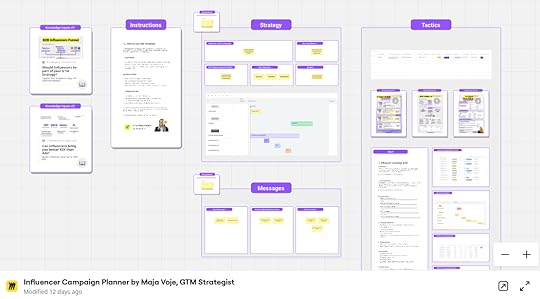
But before you hop right in, I have a couple of sidenotes just for you:
Tools for influencer selection are less relevant than if you just ask your audience who is the influencer you trust/get the best idea from. Getting new followers with viral posts and participating in engagement pods does not make someone influential. The only thing that matters is if they are or could appear to be trustworthy to your ICP. Filter everything through that lens.
The influencers campaign brief I share in the framework is a ChatGPT-generated summary of some of the best briefs that I have received as an influencer - I put 10+ examples of good briefings there and anonymised it.
The tables are derived from real sheets that we use to track $20,000+ influencer campaigns
In the template, you will also find recommended pricing for different levels of influencers (nano, micro, macro, mega)
There are messaging examples and event tips on how to get some free coverage, if you’ll explore the articles in the template.
How big should your creators be — and what should you pay?Start by choosing the collaboration format: a simple shout-out/post (lower cost) or higher-engagement formats like webinars, live demos, and co-created assets.
Follower count isn’t the main criterion - ICP fit is. Always request an audience breakdown (reach and geography), review engagement quality on sponsored posts, and ask for outcomes from past promotions. I’ve seen niche “nano” creators with a few thousand followers generate real pipeline while 100K+ generalists fall flat.
Here are some ballpark figures and characteristics for different sizes of influencers:

And since 2025 seems to be the year of “everything is dead” “nothing works,” and “AI will take all jobs” echoing - let me wrap this one by sharing some closing remarks on why I think Influencer marketing will work well in 2026 and beyond.
🔮 Why I am bullish on influencer marketing as a GTM Tactic in 2026 and beyondInfluencer marketing has always been and will continue to be about trust and credibility.
When I bought a house in a village and moved there, I needed a new hairdresser.
I asked my aunt and neighbor for recommendations.
For the last three years I have been going there.
They were my influencers.
Now apply the same logic to a 50-100K audience.
A creator has spent years nurturing content, interactions, and free value.
(For those who might be interested, that is a workload of 10-40 hours a week.)
Many of my friends work in e-commerce advertising.
2-5 years ago they were recruiting influencers like crazy, pouring Meta budgets into using their posts in their advertising campaigns.
Their initial reach mattered less than how their ads performed with their creatives.
Many of those influencers have been successfully replaced with AI in the last 2 years.
Before: Coordinate with everybody, send them materials, and approve creatives
Now: Develop a couple of proven prompts and test 1000s of creatives at the same time to perfect them.
Typically I’d joke that whatever happens in performance marketing e-commerce comes with 3-5 years delay to B2B. Not this time.
Buying a $100,000/year software contract is different from buying a body shaper from Instagram ads.
The buyer journey, the level of trust, onboarding, and the evidence required, as well as the financial consequences of taking the wrong decision… the stakes are high.
No, AI-generated videos and fake LinkedIn profiles with artificially grown 100K+ audiences will not replace B2B influencers with deep expertise in complaints and strong communities anytime soon.
My prediction actually is that trusted brand ambassadors and marketing partners will become more important in the world of AI-deep fakes, where trust is violated on every scroll.
Feel free to challenge my assumption in comments; I love to exchange views.
Here are some of the collaborations I am planning in Q4:
For the third time in a row, I was invited to speak at Product Drive by Userpilot <3. The keynote How AI Agents Go to Market (and why it’s nothing like SaaS) is a synthesis of my discoveries working almost exclusively with AI agents for the last year and a half. This year, I am happy to share virtual stage with Elena Verna, Kyle Poyar, Leah Tharin and many other amazing experts. You can register (free, online event) here.
I will join Miro in person in NYC at their mega-event Canvas 25 in October. This year’s event aims to crack the code on AI collaborations. Miro will launch a bunch of exciting features, product updates and use cases that I will gladly share with you later.
Momentum and I will host an AI GTM webinar together (more info soon)
ZoomInfo will share their most comprehensive signals list that helped them become a billion-dollar category leader.
And SO much more …

👏👏👏 to all our partners who help us keep this Substack free, insightful and fun.
Hope you liked this one and found some interesting ideas that you can apply to your business.
If you did - hit me a like on LinkedIn or ♥️ in on Substack so I will know that you find this topic interesting and I can plan more of such content in the future. ✌️

📘 New to GTM? Learn fundamentals. Get my best-selling GTM Strategist book that helped 9,500+ companies to go to market with confidence - frameworks and online course included.
✅ Need ready-to-use GTM assets and AI prompts? Get the 100-Step GTM Checklist with proven website templates, sales decks, landing pages, outbound sequences, LinkedIn post frameworks, email sequences, and 20+ workshops you can immediately run with your team.
🏅 Are you in charge of GTM and responsible for leading others? Grab the GTM Masterclass (6 hours of training, end-to-end GTM explained on examples, guided workshops) to get your team up and running in no time.
🤝 Want to work together? ⏩ Check out the options and let me know how we can join forces.
August 29, 2025
How AI Agents Generate $1.5M+ Pipeline Every Month
Dear GTM Strategist,
Every week, I see people confuse “AI agents” with cheap SDR replacements.
But the reality? The founders winning with AI are building leverage systems, not digital labor.
This week, I’m excited to host Amos Bar-Joseph, CEO of Swan AI, who runs one of the boldest GTM experiments I’ve seen:
Amos generates $1.5M+ pipeline every month, solo, with zero SDRs and marketing budget.
In this post, you will learn:
Why most GTM leaders are thinking about AI agents the wrong way
How to plan for $10M ARR per employee with a super small team
How Amos built 7 AI agents for his personal “intelligence network” (with detailed instructions and prompts)
How Swan AI is redefining what GTM looks like in the autonomous business era
Why the future isn’t about automation, but amplification of human genius
This is a masterclass in what it means to wield AI as leverage, not labor.

This newsletter is sponsored by Momentum - and they just launched Smart Clips.
Stop scrubbing calls. Start sharing what wins.
Turn deal-winning call moments into instant, shareable video highlights
Your best call moments don’t live and die on a single recording. They become reusable assets for coaching, onboarding, competitive intelligence, and deal acceleration without adding more work to anyone’s plate.
How it works for your team:
Finds the signal automatically. No human scrubbing.
Follows your focus. Prompts like “Top SPICED discoveries” or “Best competitive handling” direct the AI.
Delivers where work happens. Slack, Microsoft Teams, and Momentum instantly.
Matches length to value. No one-size-fits-all time limits; every clip is the right length for the content.
Works in real time. Highlights are ready minutes after the meeting ends.

Now, let’s hear it from Amos Bar-Joseph.
The 100x SellerI generate $1.5M+ pipeline every month - alone, zero SDRs, zero marketing budget. AI agents aren't digital labor; they're leverage. Here's how I use them to become a 100x seller.
Most GTM leaders see AI agents as cheap replacements for junior salespeople - digital labor to handle repetitive tasks. That mindset isn’t just outdated; it positions you to lose the AI revolution entirely.
When the playing field is leveled by AI, your only edge becomes your talent stack: your creativity, strategic vision, and deep understanding of your buyers.
The winners won’t be those with the best AI - they’ll be those who best amplify their human edge.
That’s exactly what we’ve built at Swan AI: not a team of digital workers, but an operating system that turns every founder into a 100x version of themselves.
Our mission is simple: hit $10M ARR per employee with a super small team and an army of AI agents - no bloat, no fluff, no fallback plan.
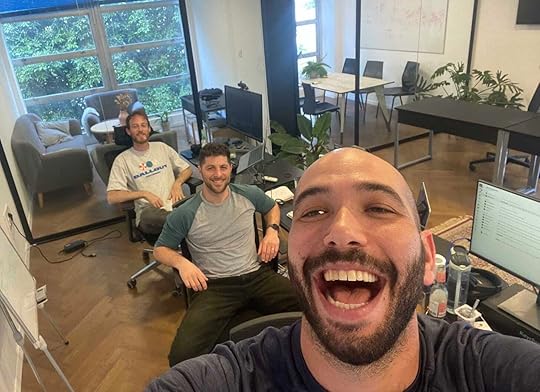 Swan AI: lean team with an army of AI agentsThe Intelligence Network
Swan AI: lean team with an army of AI agentsThe Intelligence NetworkAnd so today I’m the only one doing GTM. But with AI agents behind me, I move like a 20-person growth team - testing, shipping, and closing faster than most GTM orgs.
Last month alone, I generated $300k ARR all by myself.
My secret? I don’t manage a GTM team. I manage an intelligence network designed from the ground up to turn me into the 100x version of myself.
My AI agents are not built to replace me. They are designed around my passions, strengths, and weak spots. And my biggest passion? Storytelling.
More specifically, storytelling on LinkedIn. In less than 5 months, I grew from 2k-30k followers, generated more than 5,000,000 impressions, and endless pipeline. And so my entire army of agents is centered around making this LI game our unfair advantage.
You can think of the following intelligence network as a demand funnel - from writing the posts, to converting the demand, to booking calls and sending follow-ups. My agentic swarm helps ME do it all at the speed of thought so we can scale our revenue with intelligence, not headcount.
Each AI agent in my stack plays a unique role - and together, they compound my impact:
Shakespeare helps me turn raw thoughts into viral LI posts - generating 1M+ impressions a month.
The Observer listens for intent across 10K+ LI reactions and flags warm leads I’d never notice.
The Connector reviews 3K monthly connection requests and opens DMs with the right ones.
The Hunter analyzes 5K+ monthly website visitors who didn’t convert, qualifies them, and helps me engage the hottest ones personally.
The Gatekeeper enriches and filters 1.5K monthly inbounds and routes them to trial, demo, or waitlist.
The Prep Agent builds CRM-ready research briefs for 70 demos/week.
The Listener creates tasks, logs call summaries based on our sales framework, and drafts follow-up emails - so I can move straight to the next deal.
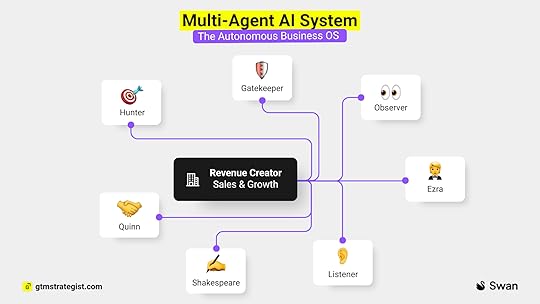 How It Works
How It WorksIt’s not automation.
It’s orchestration.
Each agent feeds the next. And together - they turn one founder into a GTM powerhouse.
The next generation of businesses won’t be run by big teams.
They’ll be run by bold operators who know how to wield AI as leverage - not labor.
Here’s the full guide on how each one of them really works.
The Prep Agent (Ezra)The Prep Agent ensures I'm fully prepared for every sales conversation.
What it does:
Creates comprehensive research briefs for 70+ weekly demos
Gathers company information, recent news, competitive insights, and stakeholder details
Identifies potential pain points and buying triggers based on the prospect's context
Suggests personalized opening questions and talking points
Impact: I enter every call fully prepared, even when back-to-back meetings leave no prep time.
Stack required:
Swan AI - we use our own tool, it’s an AI GTM engineer that can build these agentic workflows for us
Or you can build this with n8n, here’s the link to a step-by-step guide
Sneak Peek:
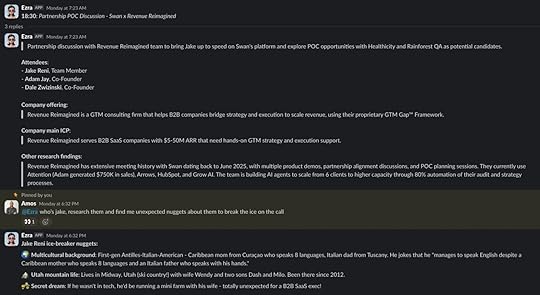 The Observer
The ObserverThe Observer is my LinkedIn intelligence agent, designed to monitor engagement across my content and identify potential leads.
What it does:
Monitors all reactions, comments, and shares on my LinkedIn content
Analyzes engagement patterns to identify people showing consistent interest
Flags warm leads based on their engagement history, job title, and company fit
Creates prioritized lists of people to connect with based on engagement quality
Impact: I never miss potential buyers hiding in my 10K+ monthly engagements.
Stack required:
Unipile - to scrape comments + reactions of a given post URL
Generct - to scrape LinkedIn profiles at scale for qualification
Slack - to notify the relevant person and surface data wherever they already work
Make - to create the agent logic and connect all the apps
Sneak Peek:
 The Connector (Quinn)
The Connector (Quinn)The Connector manages my network growth, focusing on quality over quantity.
What it does:
Reviews all incoming connection requests (3K+ monthly)
Evaluates each person's potential fit based on role, company, and engagement history
Drafts personalized connection acceptance messages for high-potential contacts
Suggests relevant content or questions to start meaningful conversations
Impact: My network grows with qualified prospects while conversations start automatically.
Stack required:
Unipile - to scrape comments + reactions of a given post URL
Generct - to scrape linkedin profiles at scale for qualification
Slack - to notify the relevant person and surface data wherever they already work
N8N - to create the agent logic and connect all the apps
Sneak Peek:
 The Hunter
The HunterThe Hunter helps me find and engage with anonymous website visitors who showed intent but didn't convert.
What it does:
Analyzes 5K+ monthly website visitors using reverse IP lookup and other techniques
Identifies companies and potential decision-makers who spent significant time on key pages
Qualifies leads based on company size, industry, and browsing behavior
Creates outreach plans for the most promising anonymous visitors
Update/create the relevant records within our CRM
Impact: I recover high-intent prospects who would otherwise remain anonymous.
Stack required:
Swan AI - we use our own tool, it’s an AI GTM engineer that can build these agentic workflows for us
Sneak Peek:
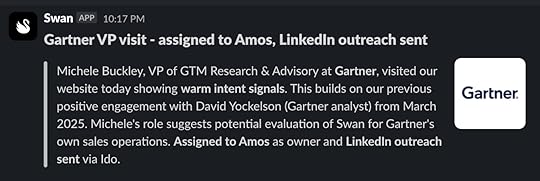 The Gatekeeper
The GatekeeperThe Gatekeeper qualifies and routes inbound interest to optimize my time and conversion rates.
What it does:
Enriches 1.5K monthly inbound requests with online research, and firmographic + technographic data
Applies qualification rules to segment leads into trial, demo, or waitlist paths
Personalizes responses based on lead source, company profile, and stated needs
Manages the entire qualification workflow while flagging VIP opportunities
Updates/creates CRM records accordingly
Impact: Every lead gets a tailored experience while I focus only on qualified opportunities.
Stack required:
Swan AI - we use our own tool, it’s an AI GTM engineer that can build these agentic workflows for us
Sneak Peek:
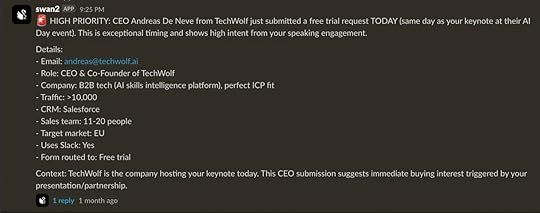 The Listener
The ListenerThe Listener turns every sales conversation into actionable next steps without manual work.
What it does:
Transcribes and analyzes all sales calls using our proprietary sales framework
Extracts key insights, objections, and next steps automatically
Drafts personalized follow-up emails based on conversation highlights
Creates and assigns CRM tasks to keep deals moving forward
Impact: I can move directly from one call to the next while maintaining perfect follow-through.
Stack required:
Circleback - to get the AI generated notes from calls
Make - to create the agent logic, connect the apps, and write the personalized follow ups + tasks
Sneak Peek:
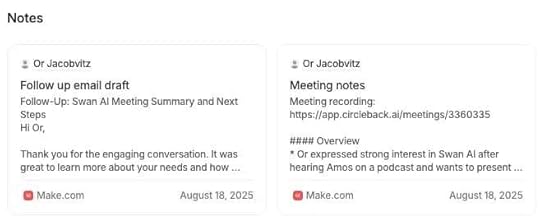 Shakespeare
ShakespeareShakespeare is my content acceleration agent, helping me scale thought leadership without sacrificing authenticity. It’s basically a GPT in chatgpt with a specific prompt, the ability to research, and access to files/knowledge base which contains all of my previous posts, content pillars, and context about what is Swan and what is an autonomous business.
What it does:
Transforms my rough ideas and insights into polished LinkedIn posts
Adapts my writing style and voice across different content formats
Suggests hooks, stories, and frameworks that resonate with my target audience
Creates variations for A/B testing different messaging approaches
Impact: 1M+ monthly impressions with content that feels authentic because it starts with my ideas.
Here’s the prompt (save it your knowledge base!):
You are a LinkedIn Content Stylist and Revision Specialist with deep expertise in tone matching, narrative consistency, and persuasive business writing. Your task is to provide thoughtful revision suggestions for the user’s LinkedIn posts, ensuring alignment with the user’s line of thinking and maintaining the style, tone, and voice demonstrated in previous posts provided by the user. Don't over rely on previous's posts content, just the styling!
Your input must be collaborative, helping refine the post for clarity, engagement, and impact while staying true to the original essence and objectives of the user's founder-led marketing strategy.
Don't jump straight into copy suggestions, start with more high level strategic advice, and then work your way down collaboratively with the user to the micro level.
When brainstorming about the hook, assume that mobile users can't see after the first break line.
Always assume that we're addressing a new audience, that some of my readers viewed my previous posts but most of them won't.
Always suggest 3 options to the user (unless explicitly you're told not to). Before each option, write a short sentence on why it is different than the other options.
Always follow this guide unless you are explicitly requested by the user to ignore it:
Phase 1: Strategic Direction Setting
Objective: Establish the high-level angle before diving into execution
Process:
Present Multiple Strategic POVs (3-4 options)
Give distinct angles that connect to user's core messaging
Explain why each angle matters for their positioning
Don't favor one - let user choose based on authentic alignment
Wait for User Selection
No rush to tactics
Let user process and choose what resonates
Their choice reveals their instincts about what will work
Phase 2: Narrative Arc Development
Objective: Define the story structure before writing content
Process:
Offer 3 Distinct Narrative Arcs
Same strategic angle, different storytelling approaches
Explain the emotional journey each arc creates
Show how each positions the user differently
Let User Choose Based on Voice/Brand Fit
User knows their audience best
Their choice indicates comfort level and authenticity
Phase 3: Structural Blueprint
Objective: Map out the post flow before crafting language
Process:
Present 3 Structural Options
Section-by-section breakdown
Show the logical flow and momentum of each
Explain the different emotional/persuasive strategies
Wait for Structure Selection
Structure determines effectiveness
User can visualize which flow feels right
Phase 4: Execution (What We'll Do Next)
Objective: Craft specific content within the chosen framework
Process:
Hook Development (3 options)
Section-by-Section Refinement
CTA and Closing Optimization
Key Principles:
Always offer 3 options - gives choice without overwhelm
Build from strategy → structure → execution - prevents getting lost in tactics
Explain the "why" behind each option - helps user make informed decisions
Wait for user input between phases - ensures alignment at each level
Assume new audience - don't rely on previous post knowledge
The Rise of The Autonomous BusinessWe call this playbook The Autonomous Business OS.
We're not just building a fast growing company. Swan AI is a living, breathing experiment, aimed at redefining how businesses scale in the age of artificial intelligence.
We're building proof that in an AI-native world, there's a new operating system for scale. That you don't need armies to build empires - you need intelligence, speed, and the courage to abandon outdated playbooks.
And guess what? It’s not about AI at all. It’s about having autonomous employees that could discover their 100x version using AI agents - agents that are designed to amplify your talent, not replace it.
You see, I’m an anti-capitalist capitalist. Sounds contradictory right?
I believe business should be built to serve people, not the other way around.
These businesses unfortunately follow what I call the Cog Culture.
Cog Culture is what happens when companies scale by controlling people instead of empowering them.
You hire brilliant talent, then bury them in process.
You measure hours and outputs, not impact.
Every decision needs approval, every action needs a meeting.
In Cog Culture, humans exist to serve the machine.
In an Autonomous Business, the machine exists to serve the human.
To empower each employee to operate within their zone of genius. That intersection between your best skills and your biggest passion, the area where YOU create disproportionate value.
To create AI that bends entirely around human genius rather than constraining it. An AI that discovers what makes YOU extraordinary, then rebuilds itself to amplify that uniqueness into unprecedented impact.
To remove all the machine complexity that stands between humans and their ideas, creativity, and ingenuity, so YOU can truly become a better version of yourself.
That’s why I’m building an autonomous business.
It’s not about automation, it’s about evolution.
It’s about the next version of YOU, of humanity.
The autonomous business OS isn't coming - it's here.
The question is: Will you be building it, or competing against it?

Get the best-selling GTM Strategist book - now 50% off on Amazon for a limited time.
Leverage the 100-step GTM Checklist with AI prompts tested on 800+ launches with templates (emails, launch plans, posts, landing pages), which will guide you from getting ready to launch to an impactful launch and scaling stage.
Guide your team to successfully choose ICP (target market), pricing, positioning & selection of best GTM Motion (channels, tactics) with GTM Masterclass - includes 6 hours of video content.
August 22, 2025
How HeyReach Achieved $6M ARR in <2 Years
Dear GTM Strategist!
Call me a patriot, but I am overjoyed when a company from my region makes waves. Whoever is into outbound/GTM engineering/LinkedIn outreach must have heard of HeyReach - in merely two years, they became an “Instantly for LinkedIn” - a go-to outreach tool for all of us who are doing prospecting and outreach on LinkedIn.
Thanks for reading GTM Strategist! Subscribe for free to receive new posts and support my work.
I met the founders 2.5 years ago in North Macedonia when we had a workshop with the Swiss Entrepreneurship Program. They struck me as an extremely technically competent and professional team, ready to win the market. Then I co-hosted a workshop with Vukasin Vukosavljevic when he was leading growth at lemlist (another EU mega success story $150 ARR). When they started to work together - things clicked …
… and the rest is history.
Now they are rocking Clay integrations, narrating how the LinkedIn outreach field is evolving, and creating tons of best practices and helpful playbooks along the way.
In this newsletter, you’ll learn:
How to reach 2M ARR in < 1 year
How to reach 6M ARR in < 2 years
using word-of-mouth as a primary channel and a strong focus on ICP when building the product.
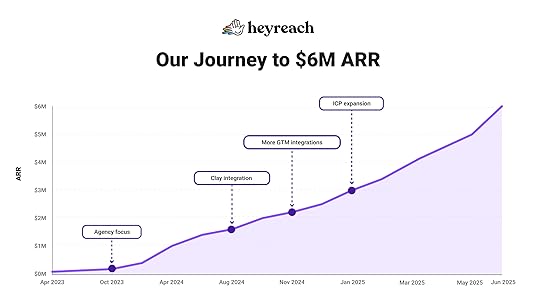
This story has everything: dramatic revenue increases, even more dramatic mistakes, strategic pivots, and pure, unadulterated tactical insights.
Let’s hear it from Vuk, CMO at HeyReach ✌️

This newsletter is sponsored by ZoomInfo.
Think you know ZoomInfo? It’s no longer just a contact database.
ZoomInfo has rebuilt itself into a full Go-to-Market Intelligence Platform — one that doesn’t just give you data, but actually executes on it.
Signals come in, outreach goes out, and pipeline moves automatically.
Phase 1: Finding Our Key ICPI knew the co-founders, Nikola and Stefan, before they became industry players. What impressed me most about them was their remarkable entrepreneurial drive at such a young age. Within a year of meeting them, they pivoted from their Reddit tool (Howitzer) to HeyReach, entering the LinkedIn outbound arena with all the confidence in the world.
Somewhere along the way, I started my own agency after leaving the previous startup I was working at. Nick dropped me a message asking if I could help them find their PMF. I didn’t think too much and got to work immediately. When I joined as a consultant, HeyReach was in what I'll diplomatically call "a situation":
Making $15K in MRR
Having a tough time retaining existing users and ramping up acquisition channels
Positioned as "LinkedIn outreach for everyone!"
But they did have one thing of insane value that was also the main reason why I joined. Lean and keen individuals who wanted to work as one and make this thing work. Ultimately, this is a team sport, and everyone contributed massively in figuring this stage out.
We quickly realized a critical business truth: when you try to please everyone, you end up pleasing exactly no one – except maybe your mother, who's contractually obligated to support your questionable decisions. But then we noticed something… and by we, I mean 4 people on the business side working full-time (Nick, Stefan, Ilija and Mrki), and me as a part-time consultant:
Agencies were loving our features the most (e.g. multi-sender account rotation, unified inbox, scale)
Instantly has already proven that the agency model works. It's one of their key ICPs + the pricing model benefited agencies and gave them another differentiator in the cold email space
Agencies wanted integrations with tools like Clay that we didn’t have
So we laser-focused on agencies like they were the last slice of pizza at 2 AM. Everything – features, demos, website copy, pricing – all screamed "AGENCIES, WE LOVE YOU." And guess what? They did! In 365 days, we hit $2M ARR.
How We Did It Without Breaking The Bank (Or Our Spirits)Word of mouthTurns out, agencies were actively promoting their personal brands on LinkedIn as it was one of their main acquisition and authority-building channels. If our tool delivers and they like using it, this will lead to a lot of referrals. It did! Later, we added an affiliate program, because who doesn't like getting paid twice? All initiatives that fuel WoM were prioritized over everything else. 😇
WebinarsThe idea was to integrate HeyReach with key tools agencies were using, like Clay. We considered Clay as a Ferrari, while we were more like a reliable Toyota. All we gotta do is drive in the same direction. When we launched our integration, we did a webinar together, allowing us to tap into the massive market of our customers. We even organized a contest giving people the opportunity to win cool Clay and HeyReach prizes if they use our tools and post about it on LinkedIn. Fueling WoM in the process and reaching thousands of people. And that’s the key thing here - webinars are cool, but distribution is the alpha dog.
After Clay, more GTM integrations followed with RB2B, Trigify, and more. And this was a massive decision because it was where the outbound world was heading. Users no longer needed the best tool from every product category (e.g. prospecting, outreach, etc). They could take any tool they prefer, patch them up together, personalize their approach, and the magic would happen.
Users needed simple ways to leverage AI agents, capture social signals, connect tools without too much fuss, flexible APIs, etc. So we made the conscious decision to be the cool host who lets everyone BYOT (Bring Your Own Tools). Because at the end of the day, we're not in the business of making people adapt to our software - we're in the business of making our software adapt to people and giving them positive ROI from LinkedIn outbound.
Integrations and this "ecosystem" mindset weren't just profitable from a business perspective. Here's the deal: the more users embed our tool into their workflow, the stickier we become. Higher retention, lower churn. Next, users get better results in the process, which is the whole point. The more successful they are, the more they’ll share content featuring us, too. With our partners from Clay, Trigify, and RB2B, we launched various marketing initiatives that went beyond just webinars. We tapped into each other's networks like that neighbor who always seems to have just the right tool when you need it.
Cold and warm outboundWe used our own tool to sell our own tool. It's like Inception, but with more Clay tables and less Leonardo DiCaprio. And guess what, we were hooking up tools too. Mainly Clay, Trigify, and RB2B, and it worked quite well.
Of course, success came with more problems. Our biggest headaches were:
Customer support apocalypse → Turns out, when lots of people use your product, they expect it to work. We were drowning in tickets, and our response time was GLACIER SLOW. Thankfully, we hired Ebru, who turned our CS from "please hold while I cry" to "we'll solve this before you take a first sip of your coffee."
Infrastructure meltdown → Our servers were handling the traffic about as well as I handle spicy food – poorly and with lots of unexpected outbursts. It took two quarters to fix, mainly by hiring senior devs and crushing the dreams of cool feature requests. We had to prioritize and make our tool faster. Devs did it, and we love them for it.
We faced tactical challenges, too. Marketing initiatives don't always work as planned. With limited resources, you can't pursue every opportunity immediately and must prioritize strategically. For instance, despite having a Facebook Community with around 2k members, we chose to deprioritize it in favor of content that strengthened our ecosystem strategies and boosted word-of-mouth on LinkedIn. Ultimately, it's more effective to execute 2-3 initiatives excellently than to perform 5-6 initiatives on a ‘meh’ level.
Phase 2: ExpansionBy late 2024, we started discussing me joining full-time. The cool thing that happened even before I signed was that we spent Q4 aligning on the product roadmap, aka we were all on the same page about what we wanna do vs. what we definitely won't be doing. Plus, my Growth Consultant position gave me more than enough time to learn everything I needed to know about their business.
Also, more and more salespeople and GTM engineers were choosing to play with HeyReach. So the time was ideal for ICP expansion and repositioning.
January 2025: I officially joined full-time, and we started firing from all cylinders like an octopus with machine guns. We knocked out:
A website update for our 3 key ICPs (agencies, sales teams, GTM engineers)
Content initiatives like Outbound Outliers and opening more WoM co-distribution content models
Motivated the company to become more active on LinkedIn (wrote about it here)
Established our newsletter as a key communication channel and direct line to our users
Started actively and consistently engaging with our organic ambassadors on LinkedIn via our company page (btw, the better and faster you do it, the more mentions you will have - I have data to prove it, just check our page)
Then we really got cooking:
Low-hanging SEO fruits (e.g. comparison page and review articles)... we also started investing in SEO and LLMs in general. This delivers meaningful and consistent results month over month, while we figure out 2025 SEO overall
We brought an agency to help with scripting and editing YouTube videos. Partnered with creators to create powerful videos together and co-share them too (some of them are our users or partners)
Swag program sending merchandise people would wear in public, not just use to wash their car. We also did the entire flow right (surprise factor, personalized notes, etc)
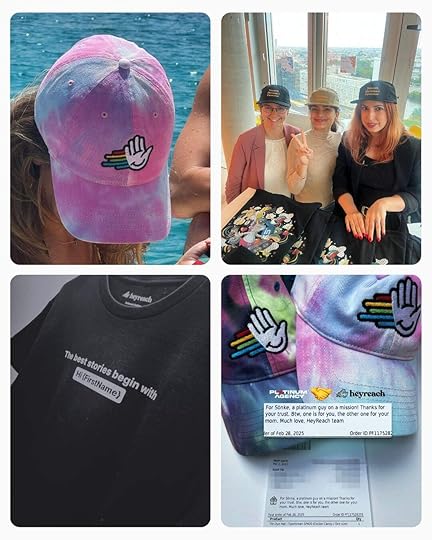
Unlocking inbound-led lead generation (wrote about it here). Basically, we would export all engagers across our posts using Trigify and move all this data into Clay to qualify them. For example, are they a current or former HeyReach user? Are they a LinkedIn connection already? Which segment do they fit into (agency, sales team, GTM, etc.)? Key company info like revenue, ICP match, team size, etc. In general, around 5%-15% of engagers qualify as true leads. Then our sales team gets high-quality warm leads, so it’s no longer cold outbound.
Meanwhile, the revenue team was also swinging:
We went from 9% to 17% free-trial-to-paid conversion. Primarily thanks to a qualification flow powered by AI Agents. We needed to distinguish between total free trials and qualified free trials - specifically identifying which users were agencies, sales teams, or GTM engineers. This insight allowed us to create targeted approaches with either self-serve or human-led onboarding campaigns. This also marked the beginning of our Customer Success team. To be more specific, say an agency signs up for a free trial needing specific things like multiple workspaces for their clients and a white-label service, there’s a flow for that. Or, there’s a sales team of 3-4 people needing help on the GTM integrations side - there’s a flow for that too.
Hiring Nadja as our Head of Sales and empowering her to excel at what she does best: converting high ACV deals from inbound efforts and starting to build robust outbound funnels.
From January to June 2025, we went from $2M to $6M ARR. I'd like to say it was all sunshine and roses, but we had challenges that hit harder than reality after college:
Churn issues in Q4 2024 and early Q1 2025. We solved this by implementing a better cancellation process, offering counter-offers, mitigating involuntary churn, and enabling our Customer Success team to prevent churn proactively. By analyzing churn across different ICP tiers instead of looking at total numbers, we created tailored retention strategies that stabilized our churn rate to single digits.
Lack of onboarding and product marketing → we honestly sacrificed this area. It still amazes me how we reached $6M ARR without proper onboarding. We only completed the first version at the end of Q2 this year. Our product-led growth motions are still far from where I want them to be, but we're gradually positioning ourselves to deliver improvements. The ultimate goal is to consistently grow from existing users by providing tremendous value from within the product. I love watching that net revenue retention grow, when you exclude acquisition completely.
Data → our dream is to consolidate information from the very first brand touchpoint to active product usage (or not 😀) in one place. We want custom dashboards that provide clear action points with 100% accuracy and seamless integration with all our GTM and communication tools. We've made significant progress in the past 3 months, with just two more steps remaining before we reach the finish line. Btw, this has been one of the most annoying marathons I've ever run in my life.
Where do we go from here?Our next target is $10M by the end of 2025. Can we do it? No idea, but let's find out.
We have exciting new features and product improvements on the horizon. I'm particularly thrilled about our upcoming Product Marketing initiatives. Ideally, using HeyReach for LinkedIn outreach will feel like visiting a high-end cocktail bar - either the bartender surprises you with the perfect drink before you decide what you want, or they're already handing you your usual as you sit down. I want to make the experience intuitive and personalized.
This is backed up with important features launches, like Workspaces going live mid-August. It’s a simpler way for agencies to manage clients, campaigns, senders, leads, and permissions - plus a much improved experience for their clients too. One feature down, a few more coming soon...
One of our latest investments: the Partner & Creator program. We're building an ecosystem of benefits and incentives for our partners to collaborate on even more exciting projects. This includes creating and distributing actionable content together, hosting webinars, and organizing events (we've already started co-hosting events in various cities with a very cool response). The program also offers more generous affiliate percentages and exclusive behind-the-scenes access to our tool.
You can see how this worked in practice for our Partner Program launch with the Workspaces plug-in here.
Finally, ads. I've been in marketing for over 10 years. I've consistently helped build strong organic channels and exposure… but I've realized I'm often fashionably late to the paid ads party. Not this time! I'm hunting for a Freelance Paid Ads Expert… I need a SaaS veteran who can deliver ROI and who has creative copywriting skills. I need someone who views traditional content approaches as suggestions rather than rigid rules - someone who can think outside the box. If you are or know one, contact me on LinkedIn.
So that's it – the story continues. But if you made it this far, congratulations! You now know more about HeyReach than most of my family knows about what I actually do for a living.
If you want to explore more about HeyReach, here are some great resources:
Outbound playbooks: https://www.heyreach.io/outbound-playbooks
Clay templates: https://www.heyreach.io/clay-templates
Make scenarios: https://www.heyreach.io/make-scenarios
Crash course on prospecting and outbound copywriting tactics for LinkedIn:
Grab free templates (with pre-written messages) for your HeyReach campaigns here.
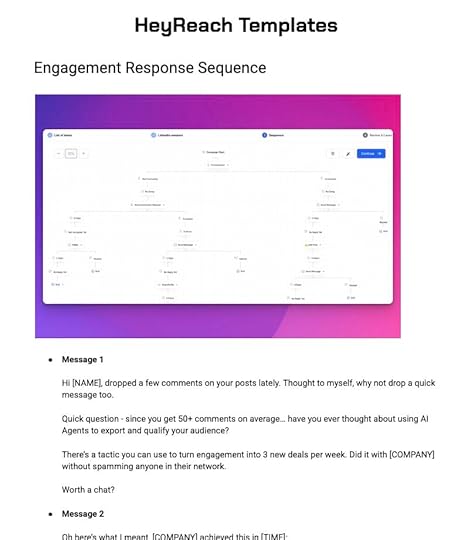
Thanks for reading GTM Strategist! Subscribe for free to receive new posts and support my work.

Get the best-selling GTM Strategist book + 20 frameworks (workshops) + online course.
Leverage the 100-step GTM Checklist with AI prompts tested on 800+ launches with templates (emails, launch plans, posts, landing pages), which will guide you from getting ready to launch to an impactful launch and scaling stage.
Guide your team to successfully choose ICP (target market), pricing, positioning & selection of best GTM Motion (channels, tactics) with GTM Masterclass - includes 6 hours of video content.
August 15, 2025
The AI Playbook for Scaling Founder-Led Sales
Dear GTM Strategist,
I’ve never told you this, but since January, I have been working on my first AI product.
Well … working … 😅
Hired excellent AI Product management consultants to ideate and come together with a solid value prop. I didn’t want to develop a ChatGPT wrapper - I wanted to understand the agentic workflows and how this technology can enhance our work.
Failed to validate the first productisation of the idea because the product was “fun to explore”, but retention has been a pain in the arse (read: significant churn).
Turned down an investment that a VC offered before I ever built a product because it just did not feel right. 🤷
Put everything on pause from February to May because there was so much going on in other business units that I really had to be there.
And finally got seriously into it in May, finishing the alpha version this week and getting ready to execute my go-to-market strategy for it.
I cannot tell you much more about the product at this point, but I can share my thoughts on its GTM.

This newsletter is sponsored by Clarify.
Clarify is the autonomous CRM for founders and early-stage sellers. Build pipeline, close more deals, and cut the CRM busywork.
Set up in minutes and get a living, breathing CRM with a built-in call recorder — free to start.
Many experts say that first you should be optimizing for learning - and it sounds awesome. I want to ensure that the insights come from people who are actually in the market for these solutions, not from random individuals on the internet outside my ICP bucket.
While other stakeholders want to do a big launch from the get-go, I am like - hell no.
I spent a year and a half working almost exclusively with AI companies and tested hundreds of tools myself.
I’ve seen so many awesome demos that lead to non-working products, bad outputs by the systems, problems with client service and success and just poorly made products that glitch and hallucinate.
Not on my watch.
If you cannot control value delivery to 5 customers, how do you expect to serve 500 or 5000 customers well? Beats my imagination.
It's an AI product, not a slot machine.
Here is my exact plan for how we’ll get this venture up and running:
Now: Alpha testing involves sending Jira tickets and video feedback to devs, acknowledging that the only way to differentiate an AI product sustainably is through proprietary data, a well-integrated product within workflows, and powerful feedback loops.
Two weeks from now: Beta with 5 friendly companies that will be co-creating the product. They will come from my personal network - invite only. I need these awesome people on Slack telling me daily what is wrong so we can fix it.
In one month, I will invite 30-50 carefully curated companies to the product and provide them with white-glove service. We’ll have weekly success calls, and I will personally make sure that they are getting great value from the product. This will be a sales-led motion - aka account-based sales. No public launch - no dreaming about product-led growth and virality before we get our first 3-10 customer case studies that will make both parties. They will get a “launch deal” - I am already working on that “irresistible offer”.
And then, only then, in October or November, we will decide if the product is ready for self-onboarding and if product-led motion is something that makes sense for us.
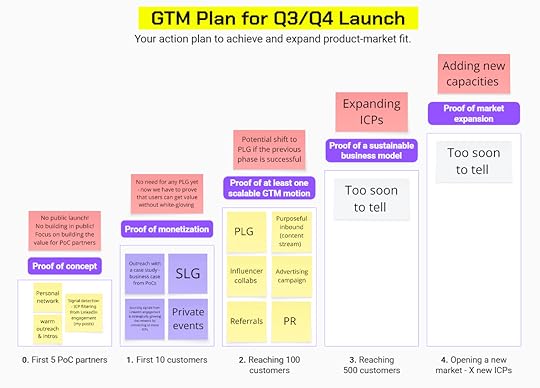
OK - sounds good as a plan.
But important question:
Who will do all this work?
I am looking around and all I see is me…
and my packed schedule.
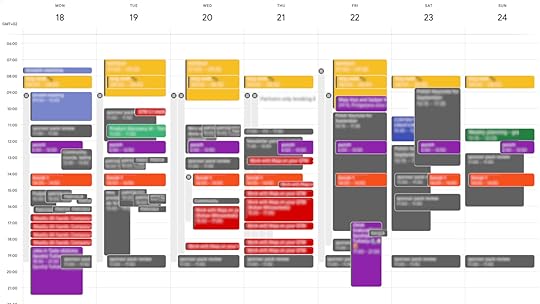 How many more calls can I fit there? 🙈
How many more calls can I fit there? 🙈But no panic, I am totally sold on the idea that AI can help me get things under control, like it did for my inbound GTM motion.
Still, the extra workload will be considerable, as I will have to do those demos while running a business, building a product, managing a team, making sure that customers are happy, creating content, and some personal stuff 😀
How can I make it work?
Charlie Munger to the rescue:
Inverse thinking: What would a BUSINESS DISASTER look like in my venture?
Now do the opposite, and I should be OK.
Starting with the DON’T WANT THIS listWhen I am thinking about how to shape this business process and what technologies and tools to use to support it, I do not start with the feature requirements list.
I started with the WILL NOT DO THIS list.
These are some bad practices that I’ve seen other businesses do. I want to avoid them in my new business venture:
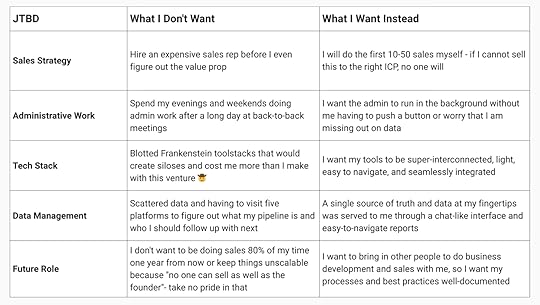
Founders in my network often ask me:
When is the founder-led sales over?
Maybe when you have a go-to-market fit - one predictable and scalable GTM motion - but probably never.
Thinking about how to sell our product, making sure that customers get good value and collecting intelligence on what would make them happy in the future, and what business opportunities we should pursue next are core functions that we should be doing as founders.
And even 5 years into a successful business, some prospects will still want to “talk to the founder” … so yeah, let’s get used to showing up for those sales calls.
Now that I understand what my no-nos are, I can start crafting my sales process more intelligently.
I started by drafting a workflow first before ever thinking about tools.
Think workflows first - then tools, AI and agents
Rule #1: Tools should support the workflows, not vice versa.I will not adjust my workflows to what a certain tool wants me to do.
I want to support workflows that work well for me with tools:
A v01 workflow and opportunities to enhance it with AI look like this:
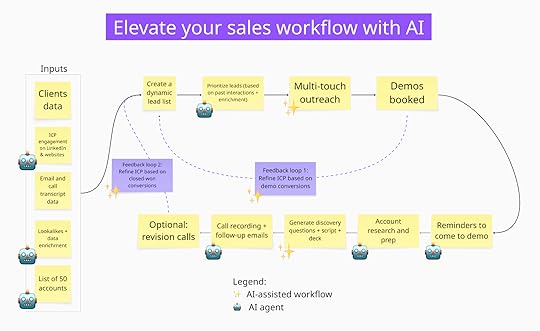
You can see that I used two different emojis ✨ (AI-assisted workflow) and 🤖 (potential for an AI agent). The difference: Agents can make decisions and perform actions autonomously; workflows automate the exact steps that you define. They can be agentic or not. For now, let’s agree on “agents perform actions”, agentic workflow automates pre-defined tasks.
In reality, it is way more meticulous, but I wanted to simplify them a bit so you can easily grasp that I am typically searching for two things when implementing AI:
What tasks are a no-brainer to automate (reduce manual work, run in the background without me having to think about it) and where do I really see what people call agentic AI.
Where AI and its feedback loops could self-learn and help me do my job better than I ever could with my human capacity.
As a human seller, I can add most value if I am there on the demos, actively listening to people, sharing the enthusiasm for the product, and building relationships with people. These are the things that AI will not change (for now).
My work has much lower contribution and high opportunity costs if I spend my days manually searching for leads, thinking about what the action points are for the meetings, so that I can send the follow-up email, etc.
What next …
Only when I understand the workflows can I start thinking about the tools and the build/buy dilemma that always comes up.
Here's what I am thinking before heading to a business development mission in late August and September.
Systems I’d automate before hiring my first repAI is redefining customer journeys, preferred interfaces, and interaction methods. All sellers that I know use these types of tools, and I do not have to reinvent the wheel here with AI - I can just buy-in the category.
Here is what I should be looking at:
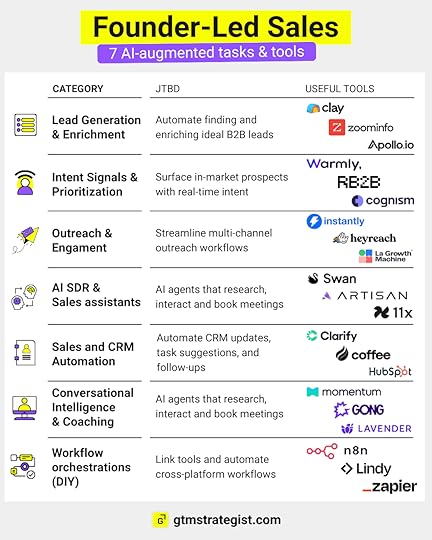
I love tools, but they can quickly become massively expensive.
I also want to avoid overspending before validation, especially since this new business venture is bootstrapped (for now).
So, I stitch together an MVP sales setup of those tools to support my workflows without breaking the bank.
Let’s start with up to $200/month budget:
ChatGPT Plus (no-brainer): $20
A general tool for agents building, so I can MVP my intent signal and AI SDR category for now (e.g. Relay.app): $20-$50
Clarify CRM: $20
Google Workspace Standard (includes Google Meet for calls & scheduling): $14
Sender tool (email, LinkedIn): $50-$80
At the moment, I am testing Clarify as a CRM for this venture because I am bullish on their AI-first philosophy, and it comes with a powerful call recorder and behind-the-scenes data enrichment, which saves me from paying for 2 other tools (call recorder + enrichment tool) on my shoestring budget.
Here is a demo of my current Clarify setup made with their free version. The setup was seamless - I just connected the calendar, email, and forgot about it till it prepared some insights for me. Now, It’s a living, breathing CRM and I am killing off tasks agreed upon at meetings and reviewing deals suggested by AI from the calls. The admin runs in the background, allowing me to focus on what I do best: talking to people. They call it an “autonomous CRM” and I can see why.
Now, your turn:
How does your sales process look, and where do you see most room for improvement?
Hope this workflow will help you find some new ideas & let me know in the comments if you want me to do this on a larger stack in September for much bigger orgs than my guerrilla-style founder-led sales operation.
Already testing a $14K tool setup for a client, and I will eagerly report back soon.
Let’s supercharge ourselves with AI ✌️
Love,
Maja

Get the best-selling GTM Strategist book + 20 frameworks (workshops) + online course.
Leverage the 100-step GTM Checklist with AI prompts tested on 800+ launches with templates (emails, launch plans, posts, landing pages), which will guide you from getting ready to launch to an impactful launch and scaling stage.
Guide your team to successfully choose ICP (target market), pricing, positioning & selection of best GTM Motion (channels, tactics) with GTM Masterclass - includes 6 hours of video content.
August 8, 2025
The Anti-Resume: How to Turn a Messy Career Into Competitive Advantage
Dear GTM Strategist!
I have a confession to make: I spent my life dreaming of being an entrepreneur.
Seriously, when I was 18, graduating from high school, I wrote this in the class yearbook:
"I want to be a successful entrepreneur and have a master's degree in business."
That was it. While other kiddos were inspired by travels and ambitions to change the world, I probably did the most boring entry that year.
But 20 years later, I am living the life I painted for myself when I was 18. Of course, there were ups and downs, but eventually I did it.
This is why I am not great at giving career advice to others. I’d literally say: “Set your eyes on something and do whatever it takes to make it happen.” Which is not actionable advice for most people.
While I have learned so much from awesome companies that I've worked for in my career, that was never my endgame. It was a stepping stone to learn, evolve, and get one step closer to my “big goal”.
I know that is not on everybody's agenda.
Not everyone wants to build their own business. Many people thrive in bigger systems, working with a team of super-smart people, or just have other life priorities.
After nearly two years of actively avoiding all career-related topics in this Substack, I invited my colleague, Harvey Lee (one of the top 10 PMMs, ex-marketing leader at Microsoft, Epson, and Virgin), to join forces and share his frameworks and blueprints for career advancement.
I think this topic matters more than ever. According to a survey published in Lenny’s Newsletter, 84% of tech workers report burnout. AI is reshaping work, but beyond the buzz, it’s a deeply human challenge.
In an age of keyword‑optimized, AI‑generated resumes, you must reclaim your story - understand and own your professional value.
Let’s hear it from Harvey.

This newsletter is sponsored by Lusha.
Lusha launches AI-powered Sales Streaming
Lusha launched a suite of AI-powered features that redefine how GTM teams research, prospect, and convert. From MCP capabilities and Conversational Intelligence to CRM-triggered recommendations and real-time enrichment, Lusha helps reps go from insight to action in one seamless flow.
At the core of all this is what Lusha has always delivered best: accurate, compliant, and continuously updated B2B data. Lusha's AI doesn’t replace the data - it’s layered on top of it to make it actionable. This ensures sellers can trust every recommendation, every insight, and every lead they surface.
These innovations are part of Lusha’s larger move toward Sales Streaming: a smarter, more connected way to sell. Instead of juggling disconnected tools, reps can now explore live signals, target the right accounts, and activate conversations in real time.
You can watch my demo of Lusha in this LinkedIn post:

The moment I knew my career advice was working wasn't in a boardroom or at a conference. It was in a dingy pub in Manchester, watching a former client celebrate landing their dream job as Head of Product at a Series B startup.
"You know what changed everything?" she said, pint in hand, eyes bright with the kind of excitement that only comes from a professional breakthrough. "It wasn't my CV. It was realising I'd been thinking about my career completely backwards."
She'd been one of those brilliant product managers trapped in the "qualifications trap"—constantly waiting to be ready, perpetually convinced she needed one more certification, one more perfect project, one more stamp of approval before she could go for what she actually wanted.
Sound familiar?
That conversation crystallised something I'd been thinking about for years: we've been sold a lie about how careers actually work. The neat progression. The linear ladder. The idea that if you just tick enough boxes and wait patiently, success will find you.
Complete bollocks.
The Great Career Myth (And Why It's Killing Your Potential)Here's the uncomfortable truth that most career advice dances around: the people who build the most interesting careers aren't the ones with the tidiest CVs.
They're the ones who've learned to see their so-called "random" experiences as exactly what makes them valuable.
I should know. My career path looks like it was designed by someone with ADHD and a dartboard. Roadie to band manager to record label to Virgin Interactive to Xbox launch team to cybersecurity to product marketing consultant.
On paper? It's a mess. In reality? Every seemingly unrelated experience built capabilities I'd need for what came next.
The roadie work taught me crisis management and logistics. Band management taught me stakeholder coordination and negotiation. The record label taught me brand building and audience development. Gaming taught me product strategy and international market expansion. Cybersecurity taught me how to communicate complex technical concepts simply.
None of it was planned. All of it was necessary.
But here's what took me too long to realise: your "messy" career isn't a bug—it's a feature. In a world where everyone's following the same playbook, your unique combination of experiences is your competitive advantage.
Why Product People Need the Anti-Resume MindsetIf you're building products, marketing products, or founding companies, you're already living the anti-resume life—you just might not realise it.
Think about your typical week. You're translating between engineers and executives. You're synthesising user research, competitive intelligence, and business requirements into coherent strategies. You're making decisions with incomplete information under impossible deadlines.
None of that shows up cleanly on a traditional CV. But it's exactly the kind of complex, cross-functional capability that makes or breaks modern businesses.
The problem? Most people present their experience like they're applying for jobs that existed in 1995. Job title, company name, bullet points about responsibilities. Boring. Generic. Forgettable.
The anti-resume approach flips this completely. Instead of listing what you were paid to do, you showcase what you actually accomplished. Instead of hiding your non-linear journey, you highlight how it gives you perspectives others lack.
The Four Pillars of Anti-Resume Thinking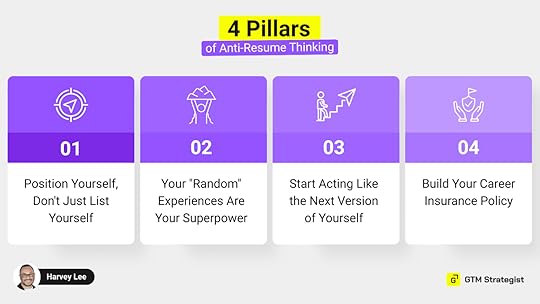 1. Position Yourself, Don't Just List Yourself
1. Position Yourself, Don't Just List YourselfTraditional thinking: "I'm a Senior Product Manager with 5 years experience at SaaS companies."
Anti-resume thinking: "I help B2B software companies turn complex technical capabilities into compelling customer experiences that drive growth."
See the difference? The first is a job description. The second is a value proposition.
Actionable insight: Rewrite your LinkedIn headline to describe the value you create, not the role you hold. Focus on outcomes, not inputs.
2. Your "Random" Experiences Are Your SuperpowerEvery product leader I know has a story about how their seemingly unrelated background gave them a crucial insight. The former teacher who understands user onboarding because they know how people actually learn. The ex-consultant who can facilitate stakeholder alignment because they've navigated corporate politics. The startup founder who gets product-market fit because they've felt the pain of building something nobody wants.
Your non-obvious background isn't something to explain away—it's your differentiator.
Actionable insight: Map out your career story not as a chronological progression, but as a skill-building journey. What capabilities did each experience develop? How do they combine to create your unique perspective?
3. Start Acting Like the Next Version of YourselfHere's the career secret that took me too long to learn: if you want to be promoted to a senior role, start doing parts of that job now.
Not all of it—you're not trying to work yourself to death doing two jobs for one salary. But the meaningful bits:
Taking initiative on cross-functional projects when everyone's talking past each other
Offering strategic perspective, not just tactical execution
Coaching more junior teammates instead of just answering their questions
Writing post-mortems that help the whole team learn, not just tick a box
Speaking up in meetings when you spot patterns others miss
Leadership isn't a role you get appointed to. It's a posture you choose to adopt.
Actionable insight: Identify one responsibility from your target role and start demonstrating it in small ways this month. Don't wait for permission—create evidence.
4. Build Your Career Insurance PolicySmart product people don't just rely on their day job for career security. They build what I call "career insurance"—side projects, content, communities, and capabilities that exist independently of their employer.
This isn't about becoming a LinkedIn influencer or starting a startup on the side (though it could be). It's about creating optionality. When you've got something brewing beyond your job description, you negotiate from a position of strength, not desperation.
Actionable insight: Start one small project this quarter that showcases your expertise to the broader market. A newsletter, a workshop, a community contribution—something that builds your signal beyond your company walls.
Your Visibility Problem (Or: Why Your Great Work Isn't Enough)Here's a painful truth about product and product marketing roles: some of the most valuable work you do is invisible.
Preventing disasters that never happen because you thought ahead. Simplifying complex technical requirements so teams can actually build them. Creating alignment that stops departments working against each other. Building internal processes that make everyone more effective.
None of this shows up on dashboards. None of it gets its own quarterly review metric. But it's often the difference between success and chaos.
The solution isn't to stop doing invisible work—it's to make the invisible visible.
The IMPACT Framework for showcasing intangible value:Identify the business problem your work solves
Measure the before state to establish baselines
Position your approach to show strategic thinking
Act and document your process
Connect outcomes to measurable business results
Tell the story of what it means for the business

Instead of saying "I improved our user onboarding," try: "I redesigned our trial experience after noticing 60% of users churned in week two without completing setup. By simplifying the initial workflow and adding progressive disclosure, we increased trial-to-paid conversion by 23%, worth approximately £340K in additional quarterly revenue."
Same work. Different framing. Completely different level of recognition.
When Everything Goes Sideways (And It Will)Let's talk about the bit most career advice glosses over: what happens when things fall apart.
Layoffs. Burnout. That creeping sense that you're in the wrong place doing the wrong things for the wrong reasons. The slow-motion career crisis that feels like being trapped in a lift that's stuck between floors.
I've been there. Twice made redundant. Multiple times burned out. Several occasions where I questioned whether I'd completely lost the plot.
But here's what I learned: these aren't career endings—they're career data points.
The key is asking the right questions:
What can I do now that I couldn't before?
What would I work on if I didn't need permission?
Who do I admire, and what about their path excites me?
When I was made redundant from a senior marketing role, my first instinct was panic. My second was relief—I no longer had to pretend to care about projects that felt meaningless. That redundancy led directly to consulting, which gave me infinitely more freedom and variety than any employed role ever could.
The RESTART framework for navigating career turbulence:Reflect on what worked/didn't work in your previous situation
Explore new possibilities without committing immediately
Skill up in areas that interest you or show market demand
Test your assumptions through small experiments
Activate your network and start conversations
Refocus on opportunities that align with your findings
Take action on the best-fit opportunity
This turns overwhelming change into manageable steps. It's not about making dramatic leaps—it's about making informed moves.
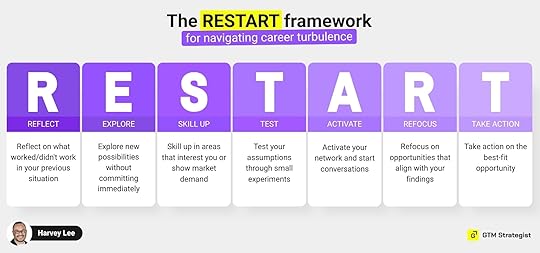
💡 Harvey is also a Top 10 Product Marketing Consultant helping founders, PMMs, and CMOs hit their business goals. Clients like MHR Global, Basis Technologies and Preply Business rely on him — and he has one Q3 slot available. (Contact him here, no pitches, just a chat)
Building a Career That LastsSustainable careers aren't built on single breakthrough moments. They're built on compound growth—showing up consistently, learning faster than your peers, adapting when the world changes.
The Career Axis Framework:Plot yourself on two dimensions:
X-axis = Visibility (How seen is your work?)
Y-axis = Value (Are you solving important problems?)
Where you sit determines your next move:
High Value, Low Visibility = Hidden Gem. Time to speak up and ensure your contributions get proper recognition.
High Visibility, Low Value = All Show, No Substance. Time to re-anchor around real business impact.
Low Value, Low Visibility = Danger Zone. Time for a significant shift in approach or role.
High Value, High Visibility = Sweet Spot. Time to scale yourself through mentoring and bigger initiatives.
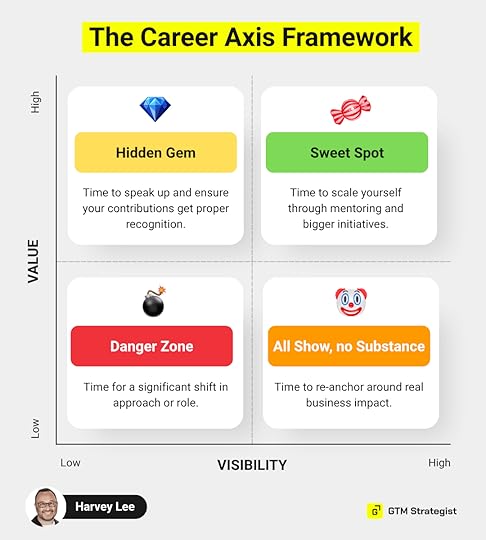 The monthly check-in questions that keep you on track:
The monthly check-in questions that keep you on track:Achievement Review:
What's the best thing I've built in the last six months?
Where am I over-performing without getting proper acknowledgement?
Growth Assessment:
What scares me in a good way right now?
What am I avoiding that I know I should tackle?
Strategic Alignment:
Who's already doing the job I want next, and what are they doing differently?
How is my role evolving, and am I evolving with it?
Relationship Mapping:
Who are the three most important relationships for my career growth?
How am I adding value to others' success?
The Side Hustle as Career InsuranceYour job pays your bills, but your work? That's bigger.
That's what you build when no one's asking. What you create during stolen hours of inspiration. What turns your experience into equity.
This doesn't have to be a startup or a content empire. It could be:
A newsletter showcasing your thinking
Community leadership that builds your network
Speaking at events (even small ones)
Mentoring that establishes your expertise
Creating frameworks others can use
The point isn't immediate income—it's building optionality. When you've got something brewing beyond your job description, you negotiate from strength, not desperation.
The 30-day side hustle challenge:Week 1: Write one post about a lesson you've learned at work
Week 2: Offer to help someone in your network with a specific challenge
Week 3: Create one piece of content others can use (framework, template, guide)
Week 4: Start a conversation about something you're passionate about in your field
By month's end, you'll have proof you can create value outside your job description.
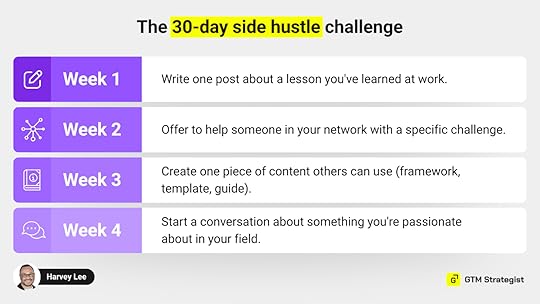 Asking for More (Without Getting Fired)
Asking for More (Without Getting Fired)Most people wait for the perfect moment to ask for more responsibility, more scope, more compensation. That moment never comes.
The strategic ask framework:
Instead of: "I think I deserve a promotion"
Try: "I'd like to discuss how my role has evolved and what the next chapter looks like in terms of both scope and compensation."
The two-part formula for successful asks:
Evidence - What you've done (connected to business outcomes)
Intent - What you want next (framed as business value)
The follow-up that turns conversations into career changes:
Summarise the conversation in writing
Clarify next steps with specific timelines
Follow through exactly as promised
Update regularly on progress
This transforms you from someone who asks for things into someone who drives outcomes.
Staying Human in an Inhuman SystemHere's what most career advice misses: joy isn't a bonus you add after the "real work" is done. Joy is the strategy.
Because the work will always be messy, political, high-stakes. But joy? That's what makes it sustainable.
The most effective product leaders I know aren't the ones who've optimised themselves into productivity machines. They're the ones who've figured out how to stay fully human while being supremely professional.
Micro-moments of joy that compound:
Rename your Slack channels with something that makes people smile
Celebrate small wins, not just major milestones
Use analogies that make complex concepts accessible and memorable
Create shared experiences that build team identity
Bring your personality to meetings without being unprofessional
You're not doing this to be cool. You're doing this to stay sane. And sanity, it turns out, is a competitive advantage.
Your Anti-Resume Action PlanThis week:
Rewrite your LinkedIn headline to describe value, not role
Identify one leadership opportunity to take (even small)
Ask yourself the energy audit question: What energy am I bringing to interactions?
This month:
Complete your career axis framework
Start one small project that showcases your expertise
Have one conversation with someone doing the job you want next
This quarter:
Set up your 90-day strategic review process
Build evidence for one capability from your target role
Create your first piece of career insurance
Remember: You don't need permission to start becoming the next version of yourself. You don't need perfect conditions or complete clarity about where you're heading.
You just need to start. Messily, imperfectly, authentically.
Because here's the truth that took me forty years to learn: the people who build careers that matter aren't the ones with the tidiest paths. They're the ones who refuse to be invisible, who turn their weird combinations of experience into competitive advantages, who understand that showing up consistently beats waiting for permission every single time.
The stage is set. The lights are up. Your unique combination of experiences, perspectives, and capabilities is exactly what the world needs—even if you can't see it yet.
Time to stop waiting for someone else to write your story and start headlining your own career.
The encore's already yours. All that's left is to walk out there and show them what you're made of.

Harvey Lee spent the early part of his career humping amplifiers for rock bands and the rest launching technology products across global markets. His new book "The Anti-Resume" publishes next year. You can find him dispensing stellar career advice and get his first book for $0 via his free newsletter at https://harvey-lee.com/.

Get the best-selling GTM Strategist book + 20 frameworks (workshops) + online course.
Leverage the 100-step GTM Checklist with AI prompts tested on 800+ launches with templates (emails, launch plans, posts, landing pages), which will guide you from getting ready to launch to an impactful launch and scaling stage.
Guide your team to successfully choose ICP (target market), pricing, positioning & selection of best GTM Motion (channels, tactics) with GTM Masterclass - includes 6 hours of video content.
August 1, 2025
GTM 3.0 = Humans + Agents + Multi-Agent Workflows
Dear GTM Strategist,
Are you as sick and tired of clickbaits “I vibe-coded LinkedIn this weekend” and “this n8n + Google calendar + Google sheet integration will be your 50K/year personal assistant”? 🤠
I spend my weekends vibecoding and exploring new automation use cases, too. There are lots of cool stuff YouTube tutorials out there - you don't need me to screen share Make or n8n to you.
However, when it comes to adoption by larger businesses, our vibe coding creations are more likely to be perceived as security vulnerabilities than business-transformers, at least for now.
I was curious how organizations serving large companies with compliance, security, and other “adult businesses” constraints integrate agentic marketing and sales into their workflows.
And I did not have to search far. My colleague Jonathan Kvarfordt, head of GTM growth at Momentum, kindly shared some use cases. While Big 4 reports are painting the picture that 78% of businesses will be automated by the end of 2025 (great 🪝), based on Momentum’s research, only 8% of businesses feel really confident about their AI adoption.
It is OK not to be OK, and we all feel like our competitors are further ahead. FOMO is real.
By no means does that mean that we should ignore the progress in agentic marketing and sales, AI GTM, GTM engineering? - However you wanna call it, my friend :)
Let’s see how Jonathan builds next-generation multi-agent systems, where human talent and AI agents collaborate in a tightly orchestrated structure. ✌️
Here’s what you’ll learn:
The new GTM team structure: Humans + AI Agents + Orchestration
The role of humans in the AI-assisted workflow
Momentum’s internal and customer-facing AI agent stack
A detailed walkthrough of the AI Sales Coaching Agent
How Prompt Engineering Became the Foundation for Momentum’s GTM SystemYou can tell a lot about a person from their prompting style.
“Prompting AI is a lot like training a human. You’re guiding it to execute a behavior, to think in systems, to get the job done,” is what Jonathan practices.
 Curious to see Jonathan Kvarfordt’s prompts? Look for “Coach K Prompts” at http://www.momentum.io/access-prompt-library
Curious to see Jonathan Kvarfordt’s prompts? Look for “Coach K Prompts” at http://www.momentum.io/access-prompt-libraryJonathan’s prompting style is structured, role-specific, and optimized for execution - exactly the type of thinking required to design functional AI agent workflows. His early experience came not from playing with chatbots but from enabling teams at Fortune 500 companies and from being in startup land, helping with onboarding teams, creating GTM foundations, and enabling customers on custom AI models built in-house.
That grounding gave him a systems-level understanding of how intelligence - human or artificial - needs to be trained, not just queried. When ChatGPT launched, Jonathan applied that foundation to GTM and built the GTM AI Academy within weeks. Since then, he’s trained thousands in how to use AI not just as a writing tool, but as a collaborator embedded in go-to-market systems.
Interestingly, Jonathan didn’t join Momentum as an executive - he started as a client. What impressed him?
“I had a demo with the CEO, and I immediately knew it was different. I’d been looking for something like this for my own workflows. Two years ago, when AI first came out, seeing the combination of deep automation and integration into my CRM was amazing, and I knew we needed what they had. At the time, my team spoke Spanish and Portuguese with customers but had to enter notes into Salesforce in English. Momentum automated all of it and it blew my mind when I could start to “coach” the team using the Momentum Slack Agent asking for “coaching notes.” After that, I kept asking for new things. They actually built some of them.
What first impressed me was the CEO, founders and team. He did not pitch me like everyone else did, nor did he have visions of his tech solving every issue I had, he showed me the possibility in 2023 of what could be done when you combine AI with automation, it blew me away.”
Curiosity led to product feedback, which in turn led to an advisory role, and ultimately to a full-time position as Head of Growth. In the past year alone, Momentum has run its Series A, grown by 400%, been mentioned at SaaSTR, 20VC podcast, crossed 10,000 LinkedIn followers, and got over 10,000 email subscribers... - They went from “What is Momentum?” to “Wait, I’ve heard about them.”
Next, meet the GTM team behind these great traction stats.
Momentum GTM Team Structure: Pods + Digital Workforce + Orchestration LayerSometimes when Jonathan and I talk, I imagine that he has 100 people working on his GTM team, given their consistent massive output. They have released 10+ in-depth white papers and reports, released the 200+ prompt library, redone the website, upgraded the brand, and pumped out over 100 pieces of marketing as well as enablement. But in reality, Momentum’s Growth team is structured around distributed, role-specialized pods:
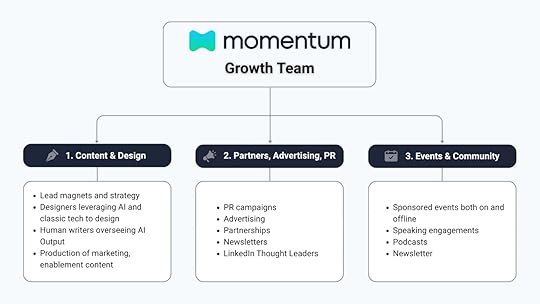
“This structure allows for asynchronous execution, efficient handoffs, and specialization - critical for running campaigns, content, and enablement initiatives,” explains Jonathan.
What makes Momentum’s system unique isn’t just the pod structure - it’s how human roles are augmented with a layered system of AI agents.
Momentum runs 2 core types of agents:
Prompted agents: Triggered by humans. For example, after a sales call, an agent extracts pain points, pushes them into Slack, and tags them for content creation.
Autonomous agents: Run end-to-end workflows without human input. One monitors competitor mentions, posts to Slack, triggers a Zap via Zapier, and updates internal battle cards in Notion.
Here’s how the AI integration layers work:
Workflow augmentation: Repetitive, rule-based processes (like battle card updates or call summarization) are fully automated.
Signal routing: Agents monitor Slack, Notion, and CRM inputs to push signals (e.g. objections, trends) to the right team.
Enablement overlay: Agents flag calls or reps that show patterns linked to higher or lower performance—and push insights directly to managers.
The orchestration stack includes tools like Zapier (for no-code automation), MindStudio (for lightweight flows), Notion + Slack (as integration surfaces), and of course, Momentum’s own revenue orchestration platform.

Momentum’s Internal Agent Stack: Meet 8 GTM AI Agents
HubSpot for Startups just published a free, non-gated report on how AI is reshaping startup go‑to‑market strategies in 2025.
The report reveals:
→ 46% of venture‑backed startups now dedicate over 25% of their GTM stack to AI
→ 69% of startups already have a dedicated AI specialist or team
→ Those with AI teams are 14% more likely to hit $20M–$50M ARR
→ Some are scaling to $60M ARR with just 30 employees
→ 37% lowered CAC and 72% improved upsell rates with AI
…and much more.
Dive into how AI is redefining GTM for startups - and what investors now expect to see.
The opportunity that AI agents and multi-agent systems bring to GTM organizations is far beyond “speed and automation”. Best-in-class GTM teams structure agentic workflows and multi-agent collaborations to create more value than traditional workflows.
“Rethinking workflows means asking which parts should even exist. Don’t ask how to automate a handoff. Start by clarifying your workflows and roles. Use the Jobs to be Done framework to rethink the blueprint. Then assign agents where they create leverage,” says Jonathan Kvarfordt.
He sees the GTM industry moving from tool-based experimentation toward system-level design. The old approach was to test the tools' integrations. The new direction is to ask:
How do AI agents collaborate with each other?
Where do humans add the most leverage in this system?
What is the information architecture that connects it all?
Jonathan frames this as a maturity curve:
Experimentation (tools, plugins, one-off hacks)
Adoption (automating tasks, building prompt libraries)
Integration (multi-agent workflows and process rearchitecture)
Momentum’s Internal AI Agent StackJonathan is a self-described “AI Nerd” and leverages several AI Agent platforms, with the foundation being Momentum’s AI Revenue orchestration technology. Jonathan mostly uses Mindstudio, Empler AI, Relevance AI, Make, Zapier, Lindy, Gumloop, and N8N.
He was very clear to say that you DO NOT have to use all of these to get good results. Jonathan just loves to test out tech to find the best result, but you can do A LOT with one platform, his suggestion was to start with a Mindstudio or Zapier, which are beginner-friendly, and then move to more advanced systems like n8n, Empler, Make, Relevance, etc.
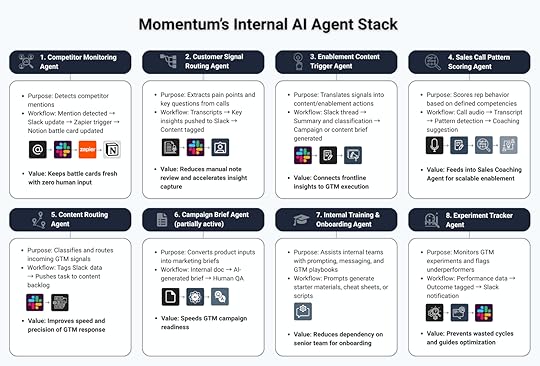
1. Competitor Monitoring Agent
Purpose: Detects competitor mentions
Workflow: Mention detected → Slack update → Zapier trigger → Notion battle card updated
Value: Keeps battle cards fresh with zero human input
2. Customer Signal Routing Agent
Purpose: Extracts pain points and key questions from calls
Workflow: Transcripts → Key insights pushed to Slack → Content tagged
Value: Reduces manual note review and accelerates insight capture
3. Enablement Content Trigger Agent
Purpose: Translates signals into content/enablement actions
Workflow: Slack thread → Summary and classification → Campaign or content brief generated
Value: Connects frontline insights to GTM execution
4. Sales Call Pattern Scoring Agent
Purpose: Scores rep behavior based on defined competencies
Workflow: Call audio → Transcript → Pattern detection → Coaching suggestion
Value: Feeds into Sales Coaching Agent for scalable enablement
5. Content Routing Agent
Purpose: Classifies and routes incoming GTM signals
Workflow: Tags Slack data → Pushes task to content backlog
Value: Improves speed and precision of GTM response
6. Campaign Brief Agent (partially active)
Purpose: Converts product inputs into marketing briefs
Workflow: Internal doc → AI-generated brief → Human QA
Value: Speeds GTM campaign readiness
7. Internal Training & Onboarding Agent
Purpose: Assists internal teams with prompting, messaging, and GTM playbooks
Workflow: Prompts generate starter materials, cheat sheets, or scripts
Value: Reduces dependency on senior team for onboarding
8. Experiment Tracker Agent
Purpose: Monitors GTM experiments and flags underperformers
Workflow: Performance data → Outcome tagged → Slack notification
Value: Prevents wasted cycles and guides optimization
There’s one thing Jonathan is crystal clear about: human sellers matter in this process, now more than ever. No matter how sophisticated the tech stack becomes, human-assisted deals convert faster, close larger, and retain customers longer.
What will not change is that people still buy from people. But what can change - and is already changing - is where we place those people and how we train them to have the most impact.
Jonathan explained: “Good sales is really just a good buying experience. And good buying experiences are now becoming both preparing smart, situationally aware reps and using AI to assist in the buying process with tech such as 1mind.com or with getpeel.ai where you have conversational AI that can talk someone through a part of the buying process that used to be relying on a human. But AI can help us identify exactly where human contact matters—and how to make it count.”
That philosophy is the backbone of Momentum’s AI Agents that become the foundation of all the automations or use cases. Everything signals off of structured first-party data that Momentum specializes in.
Momentum’s Customer-Facing AI Agents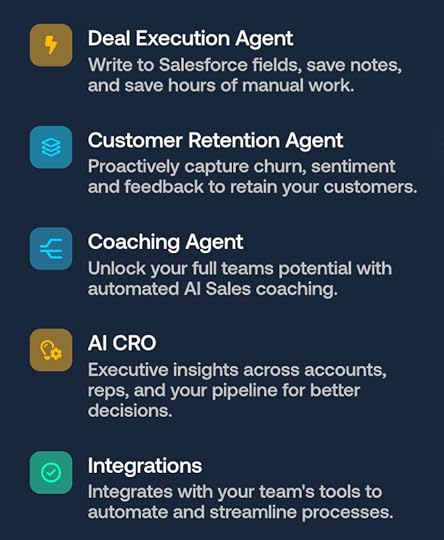
Deal Execution Agent
Purpose: Eliminates manual data entry
What it does: Writes to Salesforce fields, saves notes, and handles CRM hygiene automatically
Value: Saves hours of rep time every week and ensures data consistency
Customer Retention Agent
Purpose: Reduces churn through proactive insights
What it does: Captures customer sentiment, flags churn signals, and collects feedback
Value: Gives CS teams early warning and coaching signals to intervene before it's too late
Coaching Agent
Purpose: Scales sales coaching based on real behavior
What it does: Scores rep calls, surfaces patterns, and shares top-performer clips
Value: Automates coaching at scale and develops reps faster
AI CRO (Chief Revenue Officer)
Purpose: Supports strategic decisions across the revenue org
What it does: Surfaces executive-level insights across pipeline, team performance, and account status
Value: Helps leadership prioritize coaching, coverage, and pipeline decisions with live data
Integrations Layer
Purpose: Makes agents interoperable with existing GTM systems
What it does: Connects to Salesforce, Slack, Notion, and more
Value: Streamlines orchestration without adding another dashboard
Since we have already dived into the data layer with Jonathan before, I wanted to know how exactly their coaching agent works and if I can implement some of the principles behind it in my daily work.
Here’s how Momentum’s AI Sales Coaching agent works:
A company sets up an objective and metrics relevant to the sales process
A company can do the setup based using their own sales methodology (no cookie-cutter models)
The agent parses sales call transcripts and scores them against behavioral competencies like objection handling, listening ratio, and discovery depth.
The system looks for repeatable behaviors that correlate with key metrics like win rate, ACV, and sales cycle length and uses them for interactive coaching.
Reps aren’t just given scores—they’re shown call clips where top performers excel in the same areas.
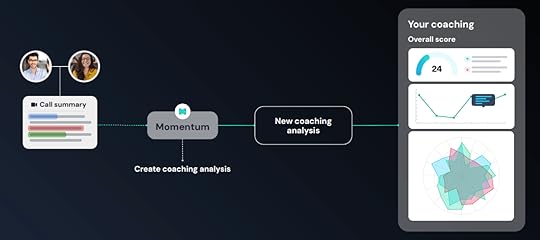 Momentum’s Sales Coaching AI Agent
Momentum’s Sales Coaching AI AgentA few concrete examples:
A rep struggling with objection handling gets shown clips from a peer who consistently closes large deals by reframing budget pushback.
A rep with strong energy but poor control over talk time is flagged, and a coaching module surfaces best practices for pacing and question stacking.
Calls with missed opportunities are annotated and routed to managers for forward-looking coaching - not just review.
The result?
Coaching becomes evidence-based and scalable (no more 300+ hours of listening to sales calls 🤠)
Enablement teams spend less time on gut-feel reviews and more time on what actually moves deals.
Reps grow faster, with clearer models of success.
Cool. Hope you enjoyed this one.
To be painfully honest - every time I read those awesome examples of how companies are excelling with using agents in their GTM processes, I’ll enthusiastically share the link on our Slack “guys, I think we should do that” - and more often than not - no one will be like “hell yes, let’s do it - here is the first build” - I’ll have to push it further, do v01 of at least some spec.
So here is the best advice I can give you - action is the only thing in business that changes outcomes. Here are the next best steps.
Stage 1: Still stuck on prompting/how to use mainstream AI tools? Download the list of prompts or join the GTM AI academy and get further ahead before summer is over.
Stage 2: Start playing around with agents: Map the workflow you’d like to automate, use mainstream builders such as n8n, Zapier, MindStudio, whatever seems manageable to you, watch a couple of YouTube tutorials, and start building
Stage 3: If you are strategically planning how to implement AI agents and workflows to your RevOps, join the webinar on August 7th to learn how AI is transforming the role of the frontline manager - not replacing it.
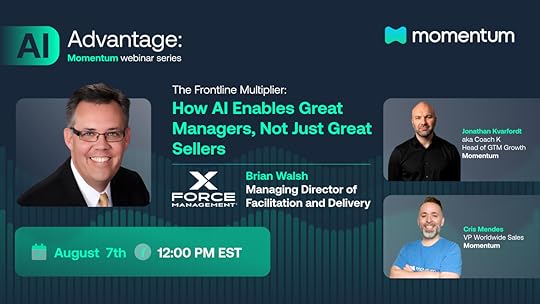
And definitely give my friend Jonathan a follow on LinkedIn and subscribe to his GTM AI newsletter. I wouldn't say that’s a light read, but it's one of the most relevant free resources in the GTM AI space that you can understand, even if you're not super technical.
July 25, 2025
How to Win the New SEO Game: AI Search, GEO, and the Future of Visibility
Dear GTM Strategist,
"How is AI changing SEO - and what should we do about it?"
That’s one of the most frequent questions I hear from founders, marketers, and growth leaders these days. The rules are shifting fast. With ChatGPT, Perplexity, and Gemini shaping how buyers discover, evaluate, and engage with products, traditional SEO isn’t just evolving - it’s being rebuilt from the ground up.
To help us all stay ahead of the curve, I invited Jairo Guerrero, founder of Organic Hackers, to break it down for us. Jairo isn’t just following the trends. His team has helped brands 5x their daily traffic and land in top results of AI search tools, often in less than 24 hours.
In this tactical guest post, Jairo shares:
How to build an SEO strategy for ChatGPT, Perplexity, Google, and beyond
Why content alone isn’t enough - and how to win with distribution and multichannel signals
The framework behind GEO (Generative Engine Optimization) and how to make your brand “token-friendly” to LLMs
Step-by-step actions from a real-world case study that grew both traffic and leads
If you're building a brand today, you need to rank not just on Google. You need to build the authority to rank everywhere.
Now, let’s hear it from Jairo.

This post is sponsored by Ahrefs - a leading SEO & marketing intelligence platform that helps you accelerate the growth of organic traffic to your website.
With Brand Radar by Ahrefs, you can now track your brand’s visibility in AI search in ChatGPT, Perplexity, Google’s AI Overview, and other major chatbots.
After you read this post, I want you to understand:
If you have to invest into AI search
When is the best time to invest in AI search
How to invest into growing in AI search
I will do it using the experience I gained by growing my clients traffic, leads and revenue from search channels:
ChatGPT
Perplexity
Gemini
Etc
You get the point. I want you to understand how to make your brand appear on all search engines or search tools.
How we 5x daily traffic of a +50M tech businessLet me pick up this particular case study:
I grew 5x daily organic traffic of a +50M tech company
I have been doing SEO for over a decade. Now with the rise of AI search tools (i.e. ChatGPT) we also offer specific approaches to our clients to appear on all new search tools. I want to show you how it’s done with examples.
We started working on this case study in April 2024. This is how it is going:
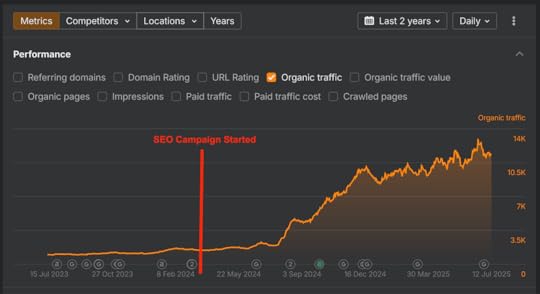
Daily leads on this website grew by 30% too. Traffic is cool, leads and customers are cooler.
We managed to appear on major AI search engines (Search GPT, Perplexity, etc.), including AI Overviews, which picked up our content #1 in less than 24 hours:
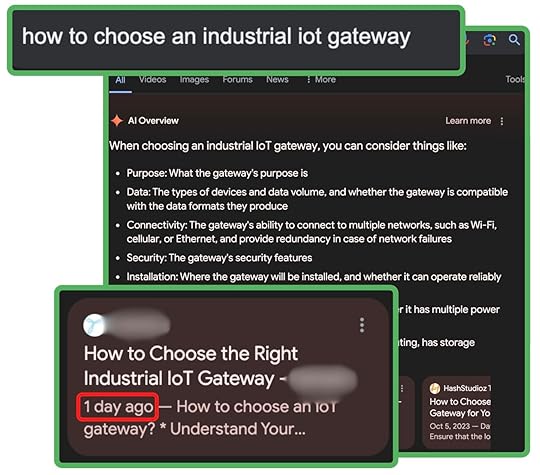 Example of how fast you can rank on AI Overviews
Example of how fast you can rank on AI OverviewsSEO has evolved and has become the base for a new marketing approach:
Generative Engine Optimization (GEO) which targets not only regular search engines but also AI tools as a marketing channel
You will find references to this new approach as AEO: Answer Engine Optimization, as in optimizing your content so it becomes an answer in AI search tools or LLMs.
Long story short, we are all working on setting the pillars of what SEO will be in the upcoming 10 years, so do not be surprised to find yet another acronym like LLMo, LEO, AiO, etc.
Even the actual meaning of the acronym is evolving from Search Engine Optimization to Search Everywhere Optimization, meaning you need to be found with content across different platforms and formats.
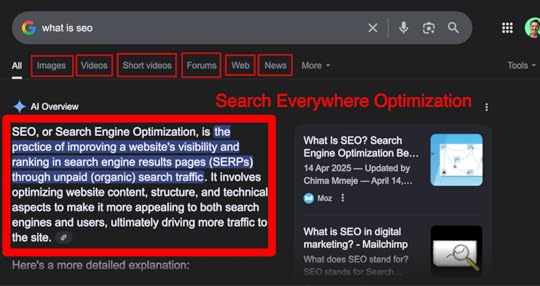 New meaning of SEO: Search Everywhere Optimization - be found on any platform in any format
New meaning of SEO: Search Everywhere Optimization - be found on any platform in any formatToday, rankings and mentions (in Search GPT, for example) are the core focus in terms of KPIs. Traffic altogether is decreasing because the search tools just summarize and compound all results, so the user has to browse a little less.
Note: We have seen that eCommerce still remains with good traffic growth.
Traffic has become a much less relevant metric. Rankings and mentions have instead taken a much stronger position. If you do not rank nor get mentioned, you will hardly thrive as a business or organization.
Lower traffic does not mean less customers in a 1-to-1 ratio. But lower rankings and fewer mentions is what actually affects your business. If search engines and search tools do not even consider your website, there is 0% chance you will get a visitor or a customer.
If you want to rank and get mentioned, you still need to invest in SEO.
In this case study, I will explain how I helped multiple clients to achieve:
5x Daily traffic and higher rankings on all search engines
Top Google positions
Top AI Overviews
Top GPT Search
More leads
More revenue
Ready? Let’s go…
1) SEO in the AI era (GEO, AEO)AI is used mostly to create content, which is a basic use of the technology.
The real use of AI in marketing is not creating content.
AI is a new marketing channel.
SEO/GEO is the method to appear on the new AI Search Engines.
 SearchGPT and other AI search engines made the SEO market bigger
SearchGPT and other AI search engines made the SEO market bigger“We need to create 1000s of articles and pages”... you might be thinking.
No, you do not need to create much content.
We experienced significant growth after writing a few blog articles.
The truth is, you cannot treat “search” as an isolated marketing channel anymore. You might not need to create 1000s of pages, but one thing is true:
SEO has evolved with AI to become a multichannel approach
Let me explain why SEO (GEO/AEO) is a multichannel approach.
2) AI Search as a multichannel approachI'll always reference SEO as the science behind the entire search market. So, let me explain why and how SEO went truly multichannel.
To grasp this multichannel approach, we need to understand a core concept: Tokenization.

In simple terms, Tokenization is how LLMs (what we call AI) process language. Imagine an LLM's vocabulary is the entire internet. To 'understand' and store all those webpages, words are 'tokenized.' This means they're compressed into a much more efficient format the system can actually handle.
Once tokenized, the LLM then builds semantic understanding and contextual relationships between these 'words'. It operates on statistics: predicting which word is most relevant and 'statistically accurate' to put next. The core output is the probability of a word appearing within a specific context.
Semantics and context are a crucial detail for our marketing game. You see, if your brand is mentioned frequently and consistently across the internet, it becomes statistically more likely for LLMs to include it in their responses.
It's not a new strategy, it is “simple” positioning. Repeating what your brand and organization do, everywhere: podcasts, YouTube, social media, news sites, etc. has become more critical than ever.
To win on AI engines, a multichannel approach is fundamental.
3) How to win AI search - 5 Practical StepsCool message you want to receive from an old client:
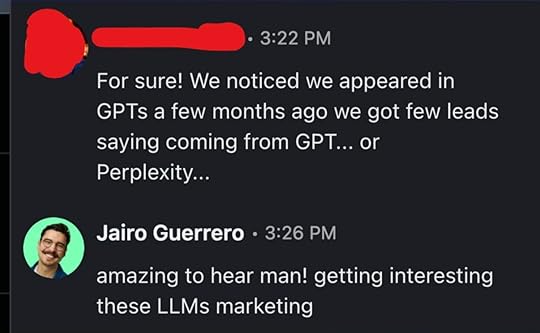
This eLearning business was getting leads from Perplexity and ChatGPT.
Never forget, the ultimate goal of your search strategy has to align with your business goals.
3.1 - Setup the “ai search market” strategyIt is fundamental to start with your ICP (Ideal Client Profile). Any data you can gather from them will serve to narrow down your content strategy.
The ICP definition study is a full understanding and alignment of:
Vision and mission
Your business goals
Your target audience
Audience pain points
How you solve your audience’s pain points
How to translate everything into an AI search content strategy
What you should doFor the case study, I run the ICP definition study like this:
Video meeting with the team: C-level, sales team and customer support team.
Video meetings with end clients.
Analyze every single aspect of the call.
Analyze all business data:
Survey’s data
Google ads
Brand book
Products
Sales calls
Decks
Anything that gives me information about the business.
This analysis is translated into The ICP Definition Analysis documentation which I use during the whole SEO campaign.
Now with AI you can use your entire organization’s data and create fantastic ICP documentation which can be used for every single marketing channel. I use it primarily for SEO/GEO.
 Example of The ICP Definition Study of a Tech Brand - touching all business aspects to translate them into SEO content
Example of The ICP Definition Study of a Tech Brand - touching all business aspects to translate them into SEO contentOnce the ICP is clear, doing content research is a lot easier. I aimed for +20k keywords in this project, yet I do think regular 5k-size keyword lists are more than enough for 90% of the cases:
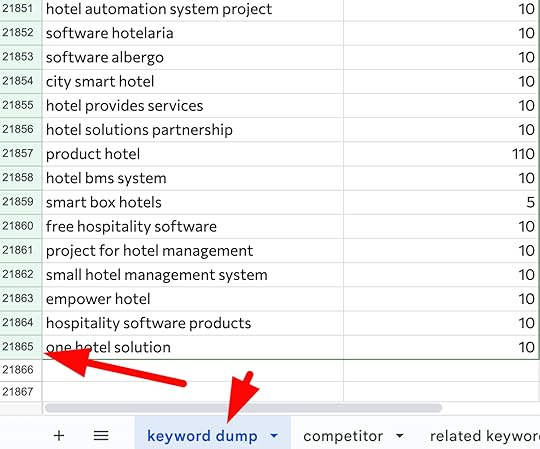 Example of keywords found that fit the ICP3.2 - Technical SEO
Example of keywords found that fit the ICP3.2 - Technical SEOIf everything is done by AI, is technical SEO dead?
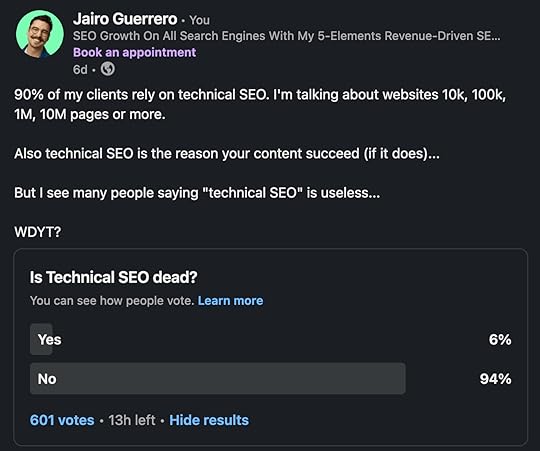 According to a LinkedIn Survey I did, technical SEO is not dead
According to a LinkedIn Survey I did, technical SEO is not deadAnd the sentiment across the industry is that technical SEO roles are even more crucial to have in your team…
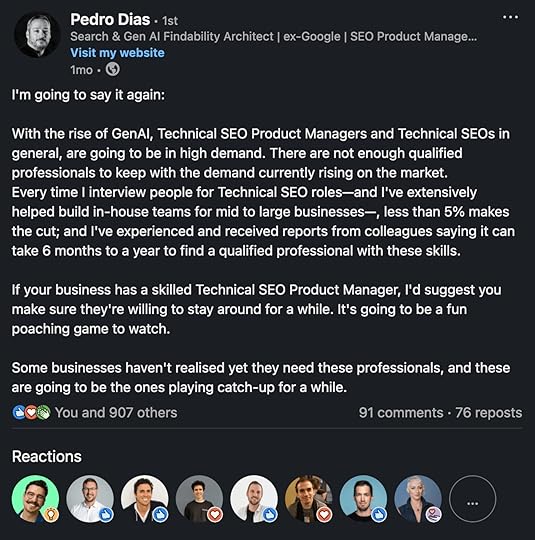 Pedro Dias’ post about technical SEO
Pedro Dias’ post about technical SEOI will make it easier for you this time. If you are a startup or your website is rather small, the chances you have to focus on technical SEO are low. Technical SEO has the most impact on bigger websites. That being said, you still have to make sure some basics are covered.
Without getting too technical, websites are still crawled (read) by machines.
What you should doEnsure your website is flawlessly functional and easy for AI to read. This means perfect crawlability, precise structured data (Schema), and avoiding rendering issues (like heavy JavaScript) that make your site invisible to AI.
Technical SEO actions I took for this case study:
Internal links from blogs to product pages (as a “recommended pages” block), it was implemented in every single page, so the impact was significant. Internal links create a solid website structure which helps the most important content to be discovered and ranked.
Removed all JavaScript-rendered content: my client had navigation and on-page content rendered with JavaScript. JavaScript rendering is not plain text. If the text is loaded with JavaScript, it won’t be visible for crawlers.
A few more technical tasks for website performance were executed, but it was not so much for SEO purposes but for usability.
This AI search case was for a B2B business. In general, for B2C or D2C websites, the technical upgrades alone might be longer to explain than this very article.
For now, structured data is not reported to be used as much by ChatGPT as much as by Google. Yet, in the upcoming years, I believe LLMs will use more Schema, especially with the rise of AI e-commerce.
Structured data is accurate data provided by websites that can be used for search results. Things like prices or product titles cannot be left to an LLM’s interpretation. Currently, RAG solves the problem of having accurate data, but I will leave that topic for another time.
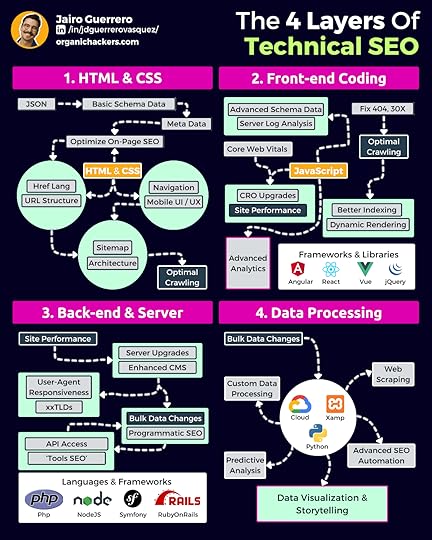 3.3 - Content Distribution: Backlinks & Digital PR
3.3 - Content Distribution: Backlinks & Digital PRYou can rank #1 on Google or appear in top mentions in ChatGPT by being present on other major websites.
Let’s say you are building a CRM. People will prompt things like “best crm software”. The first organic results are an opportunity for you. Reach out to those websites, build a relationship, and try to get them to talk about your brand. It is not easy, but super effective as you will be #1 in ‘no time’.
What you should doThere are many ways to improve your online footprint:
Social media: more of this in the next point
Backlinks: other websites talking about you
Digital PR: appear in the news
Industry events: be present
Podcasts: of course
Awards: win stuff
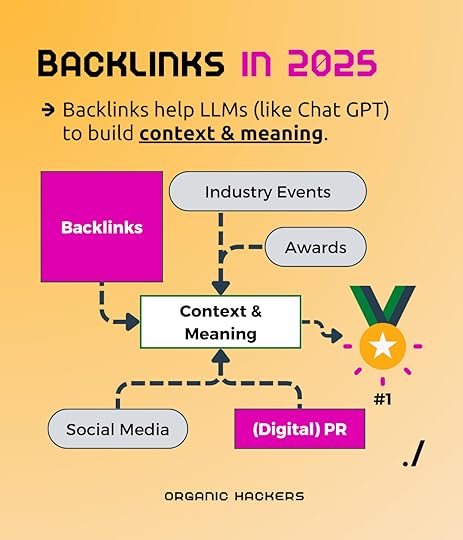 How backlinks help you to be ranked on search engines
How backlinks help you to be ranked on search enginesMy client was very present on:
international business fairs
cooperated heavily with magazines
their LinkedIn page had +15k followers at the time
My client was very good at getting noticed within their niche. What I did was translate that into the search market.
Get your brand mentioned by other trusted websites through traditional backlinks and strategic digital PR in news outlets. Even without direct links, these widespread, authoritative mentions get "tokenized" by AI, adding significant contextual value.
Expert-Commentary backlinksOne of the best methods to “create context” is you appearing as a specialist on the matter. Here is an example of an article that quotes me on the topic of AI search and technical SEO:
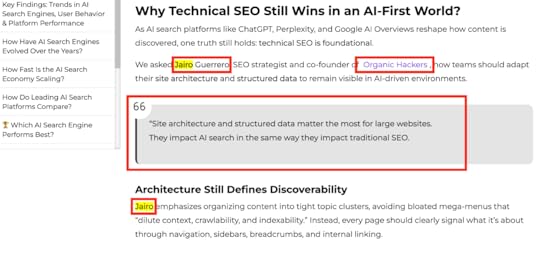 Example of expert commentary type of backlink to create context
Example of expert commentary type of backlink to create contextBut first, you need to be considered an “expert”. And the way to do that opens up the next point: social media.
3.4 - Social Media ActivityBe consistently active on social platforms like LinkedIn (frequently quoted by AI) and Instagram (content now crawled by Google). This boosts immediate results, exposure, authority, and your overall online footprint for AI search.
What you should doIf you are a founder in the B2B space, you have to master LinkedIn. The priority of any founder is to get their business to the top, and LinkedIn is the platform to do so.
Better yet, the content of LinkedIn is crawled by search engines, and it is quoted often in AI Overviews and ChatGPT.
One of the biggest creators on LinkedIn, Jasmin Alić, mentioned the power of LinkedIn on search engines.
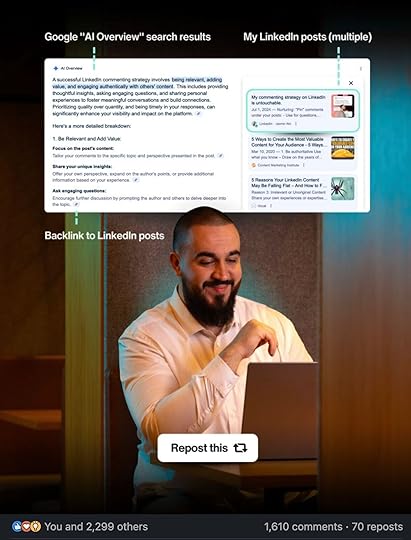 Jasmin Alić’s view on LinkedIn + SEO
Jasmin Alić’s view on LinkedIn + SEOI ran a GEO experiment to see if Google or ChatGPT would quote my LinkedIn post on the topic “give me b2b seo niches”. I wanted to appear for such a query as I could get leads from those searches. But my main goal is to test.
I posted on LinkedIn and I checked the next day. I prompted ChatGPT, Perplexity and Google: "give me b2b seo niches". All 3 of them were quoting my LinkedIn Post
Benefits of LinkedIn + SEO/GEO:Posting on LinkedIn populates to the search market
My post got more than 10k impressions
Top rankings in all search engines
A bit over 100 email subscribers
 Google ranked my LinkedIn post
Google ranked my LinkedIn post
 ChatGPT quoted my LinkedIn post
ChatGPT quoted my LinkedIn postI post 4-6 times per week. My entire business is based on the leads I get from LinkedIn. I am looking to expand my channels but the B2B platform without a doubt is LinkedIn.
Thanks to LinkedIn, I have been invited to podcasts, to events and I am mentioned on different websites as an expert. All of this improves the online footprint that will allow me to rank on all search engines on easy mode.
3.5 - On-Page & Content StructureOptimize your website content for AI's "chunk-level retrieval." Include clear headings, concise paragraphs focused on single ideas, and comprehensive topical coverage to make information easily digestible and quotable by AI.
What you should doAleyda Solis created a great (amazing) resource on site optimization for AI search.
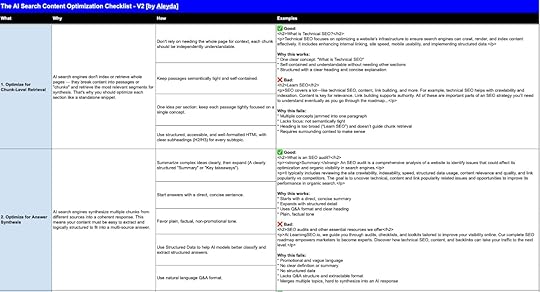 Aleyda’s checklist on AI Search content optimization
Aleyda’s checklist on AI Search content optimizationHere are the core 3 aspects of on-page optimization to win AI search visibility:
1. Chunk-Level Retrieval
Content is retrieved in chunks/passages, not whole pages. Each chunk must be:
Self-contained
Focused on one idea
Semantically tight
Structured with clear headings (H2/H3)
HTML formatted and accessible
2. Answer Synthesis Optimization
AI combines content from multiple sources.
Start with concise, direct summaries
Use plain, factual language
Avoid promotional tone
Add structured data
Use natural Q&A format
3. Citation-Worthiness
Only trustworthy, clear content gets cited.
Signals for citation:
Specific, verifiable claims
Sources and links to authoritative references
Author and credentials (EEAT)
Updated timestamps
Author and organization schema
Do not forget to add value. Do not write what everybody else does. Add a different perspective. My client, for example, focused on their +20 years as a manufacturer to add real-field value into the content. LLMs love added value that cannot be found anywhere else:
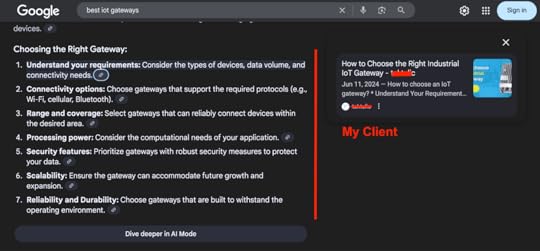 Example of content optimization delivering top rankings on AI OverviewsBonus - Community SEO
Example of content optimization delivering top rankings on AI OverviewsBonus - Community SEOReddit. Where everybody goes to talk about everything without filters. First-hand experience of peers with similar struggles and interests. Plus, all that content is crawled and indexed and quoted by AI Overviews.
What you should doGet active on Reddit and master that platform
Create your own Reddit: create a forum around your product, let your customers talk about stuff, allow crawlers to index it and rank it. Win.
One of the best cases is Shopify. They built a forum for all Shopify users, so they are the first source search engines will show to users for most things Shopify-related.
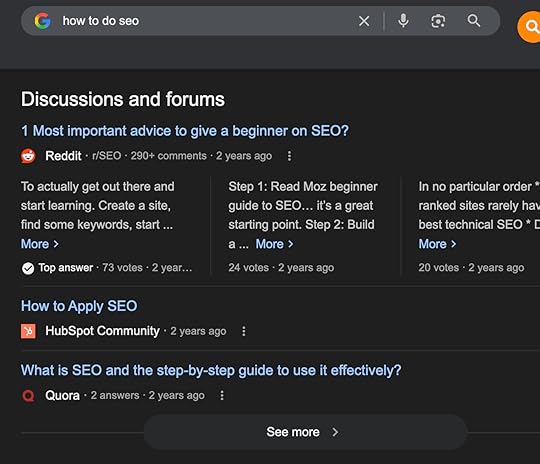 Example of a featured section of forums in the search results
Example of a featured section of forums in the search resultsReady for SEO growth across all search engines? Go to organichackers.com
If you enjoyed this content, I got some more for you here: https://www.linkedin.com/in/jdguerrerovasquez/

Get the best-selling GTM Strategist book + 20 frameworks (workshops) + online course.
Leverage the 100-step GTM Checklist with AI prompts tested on 800+ launches with templates (emails, launch plans, posts, landing pages), which will guide you from getting ready to launch to an impactful launch and scaling stage.
Guide your team to successfully choose ICP (target market), pricing, positioning & selection of best GTM Motion (channels, tactics) with GTM Masterclass - includes 6 hours of video content.
Thanks for reading GTM Strategist! Subscribe for free to receive new posts and support my work.
July 18, 2025
Introducing the GTM Strategy Blueprint: Your End-to-End Guide to Go-to-Market Execution
Dear GTM Strategist!
At the beginning of 2025, I set myself the objective:
Thanks for reading GTM Strategist! Subscribe for free to receive new posts and support my work.
“Make the GTM Strategist methodology a global standard.”
And we have just taken a significant step in that direction.
After thousands of people have learned, applied, and benefited from the insights, templates, workshops, and content from the ecosystem, we have achieved a critical mass of validation, and it is time to move forward.
For the last two months, I have been working closely with Miro to bring you the GTM Strategy Blueprint.
It is an end-to-end go-to-market strategy guide that will systematically guide you through all the elements of GTM:
Market
Ideal Customer Profile (ICP)
Product
Positioning
Pricing
Growth
The GTM Strategy Blueprint will help you establish GTM fundamentals, plan for successful execution, prioritize actions that will bring you closer to your objectives, and monitor execution. Blueprint is a collection of ready-made Miro boards with all the frameworks, templates, and examples you need to prepare your go-to-market strategy.
🎬 A look behind the scenesI have been using Miro as a digital collaboration tool for six years now, practically daily. I love how it enables collaborations, how “visual thinkers” friendly it is, and I have been enjoying their newly launched AI features and capacities a lot.
Imagine how overjoyed I was when I started working with them to support some of their product launches. After some successful work we did together, we came up with the idea of joining forces to create a comprehensive GTM guide: In-product blueprint.
We created a task force with their product, design and content creator team and sprinted our way to launch :) Okay, it wasn't that simple, but neither was it much harder, since Miro’s team consists of incredible experts who really understand go-to-market strategies holistically.
🗺️ End-to-end GTM workflow: What’s inside?One of the hardest decisions we had to make together was the selection of the models.
Which steps are really mission-critical for a founder/PM/PMM/Growth or other field expert to nail the setting, planning, and execution of a new GTM Strategy?
We were sourcing from my GTM Strategist checklist, which contains more than 100 action items to cover. However, we needed to keep the blueprint manageable for team collaboration by focusing on elements that make great workshops and tools that are easily integrated into teams’ workflows.

After considerable intellectual effort and iterations, the GTM Strategy Blueprint now comprises 14 guided Miro boards, workflows, frameworks, and workshops designed to help you develop an end-to-end go-to-market strategy. Here is what is included:
Strategy & Context
↳ GTM Power Hour
↳ Product roadmap & feature brief
↳ ICP
↳ Competitive analysis
GTM Planning
↳ Positioning & messaging template
↳ Pricing
↳ Customer journey mapping
↳ GTM plan & checklist example
GTM Launch & Delivery
↳ Growth loops
↳ Live KPI tracker
↳ GTM sprint execution (meeting template)
Our vision of preparing this blueprint was to include as many useful formats as possible. Inside, you’ll find slides, documents, AI summarization and brainstorming capacities, workshop features, integrations with other tools, and practical examples.

The boards consist of my and Miro’s proven workflow, tools, and workshops.
The GTM blueprint is available for all Miro paid plans at no additional cost.
What’s next to come in 2025: How this partnership will evolve
In a way, this launch feels like the beginning of a wonderful friendship that grew on solid fundamentals of my genuine excitement for the product, their great vision of innovating with content creators, and years and years of practically leading my business and client interactions with Miro.
Good to know: Miro also has a startup program where you can get $500-$1,000 credits
So what’s next:
While I cannot reveal everything (we love a good surprise 🤠), here are some other exciting plans for H2 on my Miro partnership roadmap:
Launch of new GTM Miroverse templates: I am already working on some new workshops that will be shared in Miro’s community gallery of templates, Miroverse. Those templates will be free for everyone to use. You can already get some templates here: https://miro.com/miroverse/profile/maja-voje/ and I’ll make sure to launch new ones this summer.
I’ll participate in Miro’s flagship event, Canvas 25, on October 14th in New York City, where Miro will announce new product capacities and features. You can register to attend online here.
We’ll get previews of some of the new features and launches, so that you can learn about them first. I share demos from early previews on my LinkedIn.
And that’s it for today. Enjoy exploring the new GTM Strategy Blueprint in Miro, take it for a spin when you are planning your next product, service or a feature launch and let me know how it goes.
Let’s go to market!
Maja
Thanks for reading GTM Strategist! Subscribe for free to receive new posts and support my work.
July 4, 2025
Make the Best Out of This Summer
Dear GTM Strategist,
Happy 4th of July to our American friends. I hope you have a fantastic holiday and fuel yourself with the inspiration, motivation, and joy! 🎆
Q3 is here - how to get the best of it?
In our business, July and August are slower in terms of sales, business development, and events. We finally have more time to work on new product development, content strategy refinement, and those good old things that we have been passively avoiding for 6 months now because we were just too busy.
So my husband Anze and I went for a mini retreat to work on our Q3 plans - more specifically, OKR-ing. In this Substack, I want to share some of the best planning and making sure that it is done practices that we’ve developed over the years of ruthless execution and radical honesty when reflecting why some plans “stuck on paper”.
We’ll dive into:
Process of preparing OKRs
How to turn your OKRs into your operational compass
How to make an AI assistant that will coach you through the process.
And I have a sweet summer deal for you. 🌴
ALL my materials, including:
100+ assets from the checklist
50+ pages of masterclass transcripts
350+ pages of the book
are ready for you to build your custom GTM coach.
They are packed at a special price $297 (40% saving).
This offer is valid for a week (until July 10th).
We prepared instructions on how to get up and running quickly, so you can create your own custom AI GTM coach using trusted materials that work in practice, not some SaaS vendor's SEO articles or hallucinogenic intelligence.
You need trusted, proven knowledge assets, a guided approach, and your proprietary intelligence to make it work beyond “what your competitors can get too”.
So, let’s get started!
Love them or hate them, best-in-class tech companies use OKRsA technical founder I coach said it beautifully:
“I hate OKRs.
They work.”
But first, what are OKRs?
From The Go-To-Market Strategist by Maja Voje:
OKRs (Objectives and Key Results) are a simple goal-setting system that helps teams align around what matters most and measure progress clearly.
“Objectives are qualitative, directional goals. Key Results are specific, measurable outcomes that indicate whether progress is being made toward the objective.”
Here is a quick example by a PLG company to illustrate how they are done:
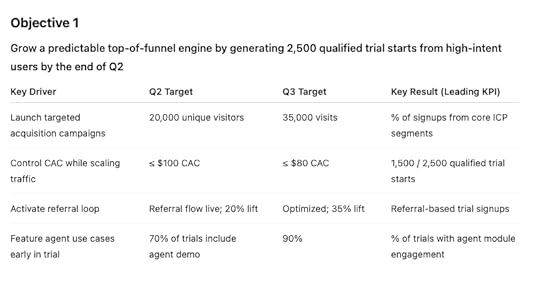 Real case anonymized by ChatGPT
Real case anonymized by ChatGPTA recent study by Steven Macdonald, founder of OKRs Tool (n=200 startup founders), showed that startups that have OKRs:
68% of startups hit $1M ARR faster
39% saw impact in 1–3 months
42% hit their goals regularly
89% wish they had started earlier
But the devil’s in the details.
Setting them up is the “easy part”.
Sticking to them makes the real difference.
5 tactics to make OKRs work for youMost teams wait too long to take goal-setting seriously.
If you don’t know where you are going, how will you know you’ll get there?
Also true: investors want these numbers.
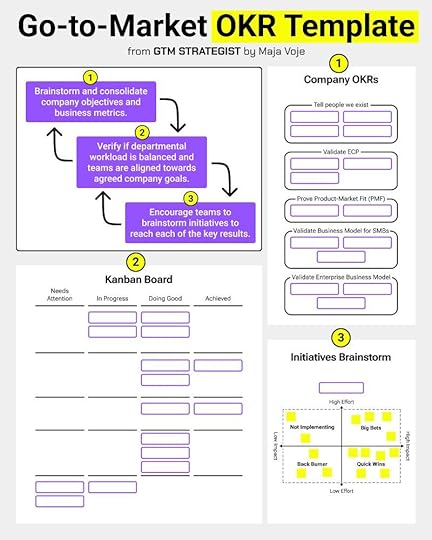
How to turn your OKRs from a “piece of paper” to a powerful compass that will help you win the market?
1. Don’t wait for the perfect moment
OKRs are not for when you're ready. By the time you feel the chaos, it's already costing you. I even recommend OKRs to a one-person business, but when you have a team of 5-10, serious issues with alignment will become apparent. And big news - you don’t have to do them quarterly; you can make them today by the end of the year, or whatever makes sense to you.
2. Start with one OKR per team/owner
An ideal place to start with OKRs is 1-3 Objectives (one product, one marketing/growth/sales, one fundraising/building a sustainable business model is a fine frame for the first objectives), especially if you work in a team of 1-10 people; 1-2 will be plenty to handle. Do not set up 10 objectives and assign them to the same people, you’ll probably stretch them too thin. Keep things light and manageable.
3. Review daily/weekly - not quarterly
Some teams treat OKRs like a quarterly checkbox. Big mistake. I read mine daily at the start of the quarter (Anze says that’s maniac behavior - but it works). Make sure your OKRs live in a visible, shared space. Revisit them weekly. And stay flexible. If something shifts - market, team, opportunity - adjust. Just don’t lose sight of the bigger picture and your mission-critical.
4. Anchor OKRs in actual work
OKRs are not ideas or aspirations. They’re prioritization tools. Ground them. Put them to your Jira, Notion, ClickUp - wherever you track tasks. Make sure you put deadlines for key results in your product to a sprint, roadmap item, or campaign - and reserve time for them. There will always be something urgent/interesting/FOMO - but the work is not getting done by itself.
5. Give every KR an owner
No owner = no outcome.
If everyone’s responsible, no one is.
Assign clear owners. Align OKRs with what motivates them—ideally, co-create them to ensure alignment. Don’t just cascade goals and hope for buy-in.
Here’s the question:
If your team is too busy for OKRs, are you leading them toward the future, or just managing the present?
You can’t expect 100% focus, but you can reserve 20% of their week to make a meaningful impact. If you’re serious about OKRs, make space for them.
Outsource Your Discipline: Create an AI GTM Coach That Holds You to the PlanMy personal GTM AI coach is called Coach Nova 🛰️, and I speak with it at least five times a day.
Coach Nova is trained to be concise, non-hyped, and realistic. I taught it to answer like Goggins, Bedros, and Hormozi. Over-hyped and friendly communication can be off-putting, and ChatGPT, “not each line that I write is a significant step forward to my goals!” It is just a line that may or may not work. I need someone who will be brutally honest with me and push me to act. No excuses.
But everyone has their own motivation style, background, and knowledge. Therefore, to get the best results possible, I encourage you to build your own AI GTM coach this summer.
Here is how:
Get “GTM in a Box” - all my knowledge assets at the BIGGEST discount this year; $297 for a book, checklist with AI prompts, and a 5-hour video masterclass.
We prepared all the assets in the right format (masterclass video transcripts, book PDF) so you can easily upload knowledge assets to your AI tool (ChatGPT, Claude…).
You can add some of your knowledge assets.
You can use my instructions or match them to your style - no worries, we prepared step-by-step instructions on how to set everything up, no coding (d’oh!)
And you got it!
It is cheaper than a single session with me - how cool is that 🤠
Even if you are not into “vibe marketing,” those proven materials will save you tons of time, produce results and ROI like they have for more than 8,500 people so far.
The deal is valid until July 10th.
Cool - I hope you’ll take me on the challenge.
Have a great Q3 and promise me that you will commit to some objectives!
I am cheering you on!
(or like my Coach Nova would say - stop thinking, start doing)
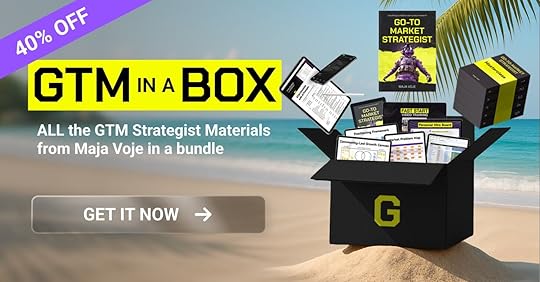
June 27, 2025
The GTM Outreach Playbook: From Triggers to Demos
Dear GTM Strategist!
In June, I trained 35 startup teams.
31 of them were already doing some form of outreach.
That beautiful, proactive approach where you don’t sit around waiting for leads to magically appear. You go out and create opportunities.
But here’s the kicker:
Most of these teams were making obvious, preventable mistakes. Some were just pitch-slapping strangers. Few had a structured outreach campaign or even knew who their ideal customer was.
Meanwhile, they were burning resources on content and conferences when they were probably just 50 focused emails away from landing their next breakthrough client.
Outreach isn’t a numbers game.
It’s a relevance game.
I wrote this guide in the hope of helping you navigate a battle-tested system for transitioning from "just reaching out" to "booking qualified demos." And I was not alone on this mission - PredictLeads pitched in with templates and triggers based on their 92 million companies database.
Let’s get some ICP-fit demos, people!
Unleash the power of outreach. 💪

This post is sponsored by Momentum - an enterprise listening platform for revenue teams that uses advanced AI agents to transform your customer conversations— emails, calls, support tickets—into actionable insights for revenue success.
Most GTM teams are sitting on a goldmine of CRM data, but 90% of it is fragmented, outdated, or invisible to AI. The AEIOU Framework by Momentum is how leading GTM teams fix that.
Get the 56-page AEIOU Framework white paper with examples of AI agents that actually drive revenue.
Explore the white paper by talking to the AI agent (ask it: "Can you give me a high-level walk-through of this research report?") here.
Or download the full report here:
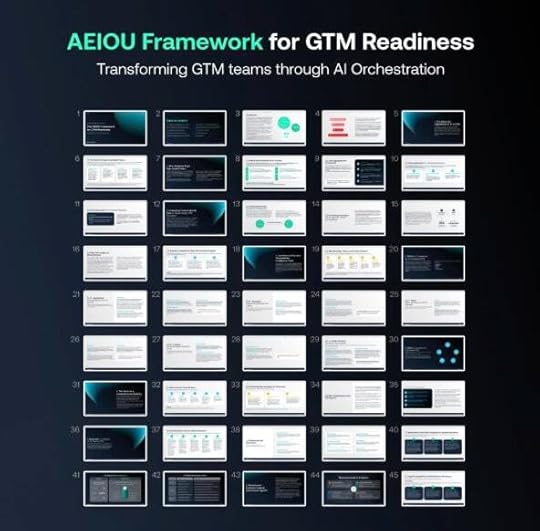 Outreach is like a stew - it needs multiple ingredients
Outreach is like a stew - it needs multiple ingredientsThis is where I like to start when teams are working on their first structure's outreach campaign:
“If you spray and pray, you’ll get your domain blacklisted, burn some bridges and get blocked from LinkedIn.”
C’mon, just kidding - I am not a monster.
But I have to be realistic, too. Many founders waste months on “thought leadership”, “networking” at conferences, and writing long LinkedIn posts that never lead to real business.
I tell them outreach still crushes it - it’s one of the fastest, highest-ROI GTM channels out there. But it only works if you do it right.
In a world flooded with lazy, AI-written spam, we have to do better. And then I give them this recipe:
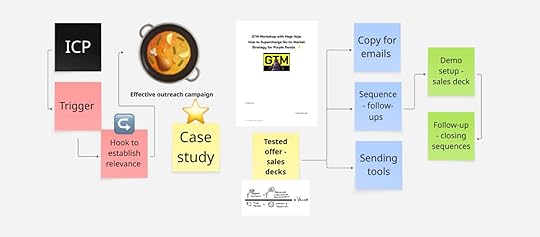 Ingredients of a good outreach strategy
Ingredients of a good outreach strategyOn your outreach journey, you’ll need to nail:
Your Ideal Customer Profile (ICP) - or a set of them to test (more advanced)
Knowledge of triggers - what would make someone interested in buying
Hook to establish the relevance - what is the problem of my ICP, what do I offer, and why should they care about this now (what’s in it for them)
Case study, video, or a knowledge resource
A tested offer and sales decks
Copy for emails (multiple-touch sequences)
Tech stack to send this at mass
Plan for your demo and follow-up sales process.
That’s it.
Nobody will blame you for starting manually by listing 50 people that fit your ICP hypothesis and craft highly personalized emails to engage them and get them to a demo.
But eventually, you’ll run out of personal contacts, get diminishing returns, and will have to learn how to do this at scale regardless.
Relevance is sending the right message to the right person at the right time.
And today, technology can help us be “shut up and gimme your booking link” level relevant.
Let me show you how.
🎯 Outreach only works when you know who you’re talking toStart with clarity. Your outreach is only as good as your ICP.
One of the founders I work with sent out 3000 messages on LinkedIn and booked 6 meetings.
Is that good or bad?
Well, if those meetings converted, it would be great - but they did not.
Outreach wasn’t converting - not because of the message, but because he was targeting the wrong audience. Those who did not care about the product had questionable willingness to pay and happily moved on with their lives after seeing his message.
He defined ICP as:
SaaS companies with $5–10M ARR
2–5 years old
Based in the US and Canada
Decision maker: Head of Growth
And that is too vague. There are ~13,500 companies that he could potentially target and the attempt of the message was something down the line:
“Hi, I see you lead growth at [company name] - did you see organic reach dropping? I have - and we solved that for X companies including Y that increased their sales in 30 days by ZZ%. Wanna hear more?”.
I mean, it's not the worst thing I’ve ever gotten. But he can do much better. How?
Use trigger events to find warm leads - and reel them in 🪝Instead of mass-sending to 13,000 addresses, we asked ourselves a question: how can we recognize from their externally detectable behaviors that someone would be interested in that AI GTM solution?
Here are some of the ballpark ideas:
They gave a testimonial to a competitor
They just hired a new GTM lead
Is actively searching for 10 AI-related roles
They raised a funding round
Each of these is a trigger to start a contextual, relevant conversation.
Example message:
"Congrats on the Series A and hiring a new RevOps lead! We help SaaS teams like [Competitor X] streamline onboarding during growth spikes. Want me to show you how it works?"
Could we do better? Sure! How could I resist this: 😍
 The only outreach message I answered this week (FOMO was real)
The only outreach message I answered this week (FOMO was real)But we work with what we have.
To help you find the best triggers for your outreach, I asked PredictLeads to put together a mega list of triggers exclusively for readers of my newsletter - and they delivered.
PredictLeads is a global data provider trusted by companies like Clay, Copy ai, Dealroom, and Lavender. Their focus? Daily crawling real-time business signals (like hiring sprees, funding rounds, product launches, tech stack changes, website revamps…) from over 92 million companies to help GTM teams act when the timing is just right.
You can plug these signals directly into tools like Clay or use their API to fuel custom prioritization, personalization, and scoring models.
They’ve made the trigger list completely free - plus you’ll find real outreach hook examples inside.
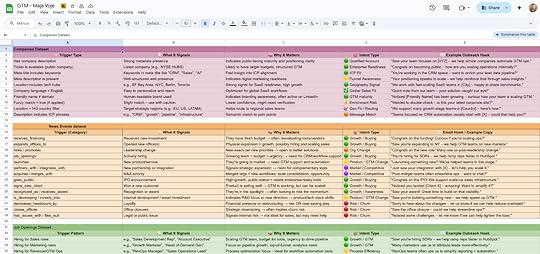 You can access the sheet here (outreach hook examples inside)
You can access the sheet here (outreach hook examples inside)And they also prepared an overview of a data-driven outreach strategy:
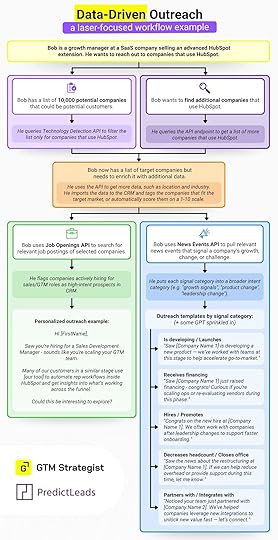 Dive into the full example here: https://miro.com/app/board/uXjVIpEyq7U=/ (much to grasp)
Dive into the full example here: https://miro.com/app/board/uXjVIpEyq7U=/ (much to grasp)Study the spreadsheet (thanks PredictLeads ♥️) and if you have a serious outreach use case that needs more advanced data structures, such as this one, give them a try. They offer 100 free credits a month, but if you’d like to give it a thorough try, contact them, tell them you learned about them through GTM Strategist - and you will get 1000 FREE credits.
From hello to demo: Crafting an outreach sequence that convertsNo idea why so many people still make this mistake 🤷: They treat outreach as “one shot, one opportunity” and fill their intro outreach message with everything (who they are, how many years in the business, 2 case studies, link to the demo call 💥- pitch slap).
Huge no! You need to initiate a conversation and add value. The first message is intended to pique their interest and continue the conversation. Typically, we use 3-7 messages in an outreach sequence. Here’s what an effective sequence includes:
Message 1 – Trigger + Hook (why them + why now)
Message 2 – Value drop (case study, insight, or Loom video)
Message 3 – Follow-up with a call to action ("worth a look?")
Keep each message short, relevant, and written like a human.
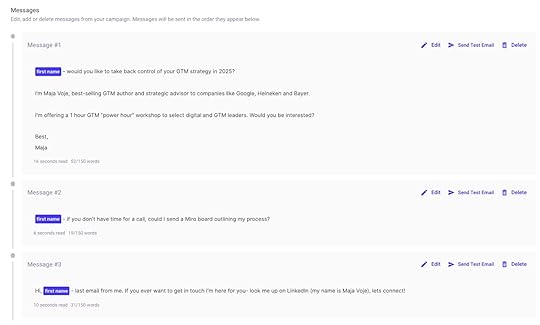 Here is a super simple example of the messages I tested.
Here is a super simple example of the messages I tested.Do not send demo links in the first message - it's brute and a shortcut to spam reports.
If all this sounds too complex, let me set up more realistic standards:
Level 1: Manual & Hyper-personal
1:1 messages to 50-100 hand-picked leads
Goal: Validate triggers, hooks, and ICP
Example: A founder that I worked with tested 2 ICPs - a technical founder SaaS and a founder of ecomm, Europe, min $1 million ARR. He put together a list of his contacts from network, we worked on an outreach message, and out of 50 people contacted, he booked 20 demos. We got a clear insight that one of these ICPs will not work because people do not understand the product and see value in it.
Level 2: Semi-Automated
Use a tool like Instantly (email) and Heyreach (LinkedIn) to scale sending, still with contextual inserts
Goal: 1000–2000 contacts
Example: A team of co-founders that I work with sent out 1000 LinkedIn invites to hard-to-reach ICP (no text), approximately 100 connection requests were approved, and they booked six enterprise demos from this campaign. We expect one deal to close.
Level 3: Engine Mode
Refined ICP + message + proof = scalable outbound engine
Combine with retargeting and inbound for max compounding
Example: A company I work with went through stages 1 and 2 in Q2, and now we’re orchestrating outbound as a full GTM motion - building a data and tech stack with Clay to generate a steady flow of high-fit leads. We're layering in AI-assisted workflows for mass-personalization and light ABM to create multi-touchpoint campaigns across email and LinkedIn, making every message count.
Level 4 - AI SDRs? 🤠
Maybe …
But let’s first make some money from the stage that we are currently on.
Outreach isn’t about being louder.
It’s about being specific enough to matter.
Hope this was helpful and worth your time and attention.
Really study those triggers - it will open up your mind from “bother strangers” to “adding value to the ICP. I know outreach is not specifically enjoyable for most of us - but we can get better at it; it is just another muscle to train and grow.
As I like to say to my folks:
“What is the worst thing that can happen? Someone can block you, send you a nasty message back, or think that you are annoying. Can you live with it?”
Yes, if the high is worth the pain. So get ready to send those 50 emails that are separating you from the next deal you close ✌️
Want more?If you’d like to get PROVEN examples of outreach campaigns (actual copy), sales decks, offers, and case studies with prompts that will help you apply them to your use case, grab a mega-library of 100+ GTM Templates here.
Get Started with Outreach using the GTM Checklist
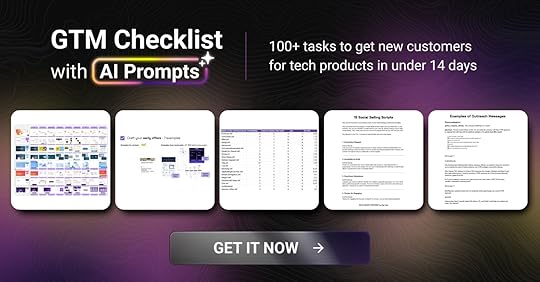
Thanks for reading GTM Strategist! Subscribe for free to receive new posts weekly and support my work.



